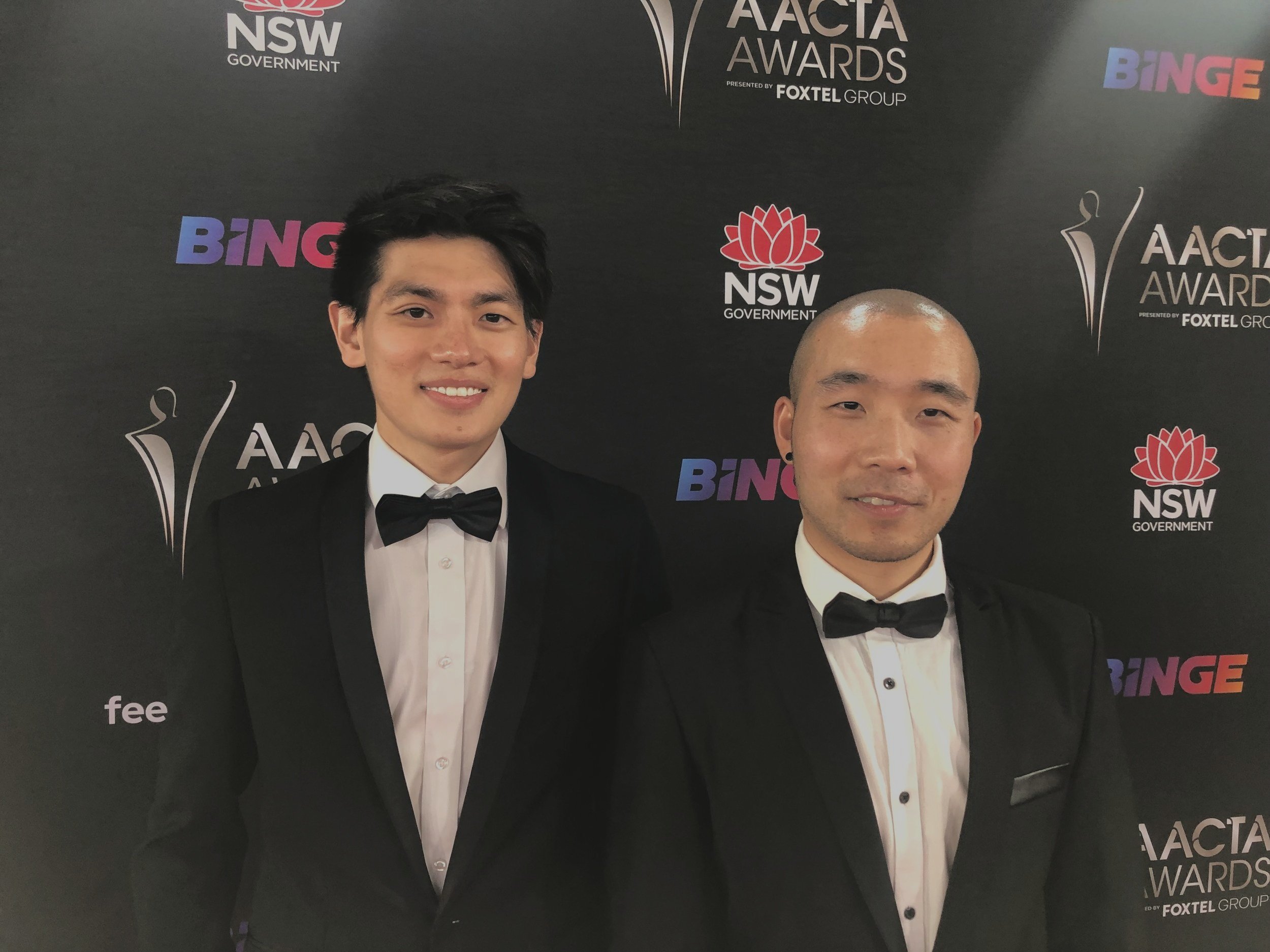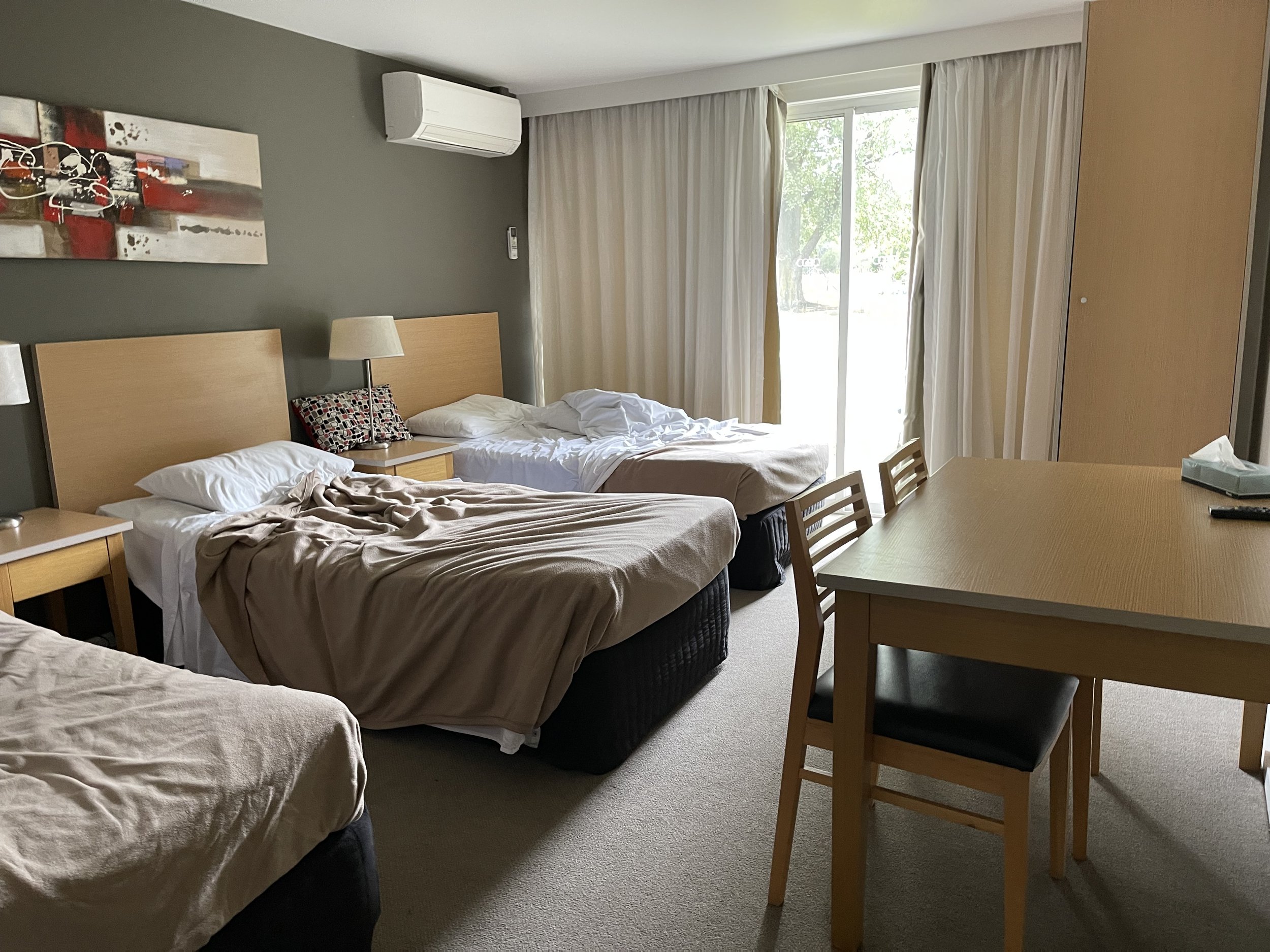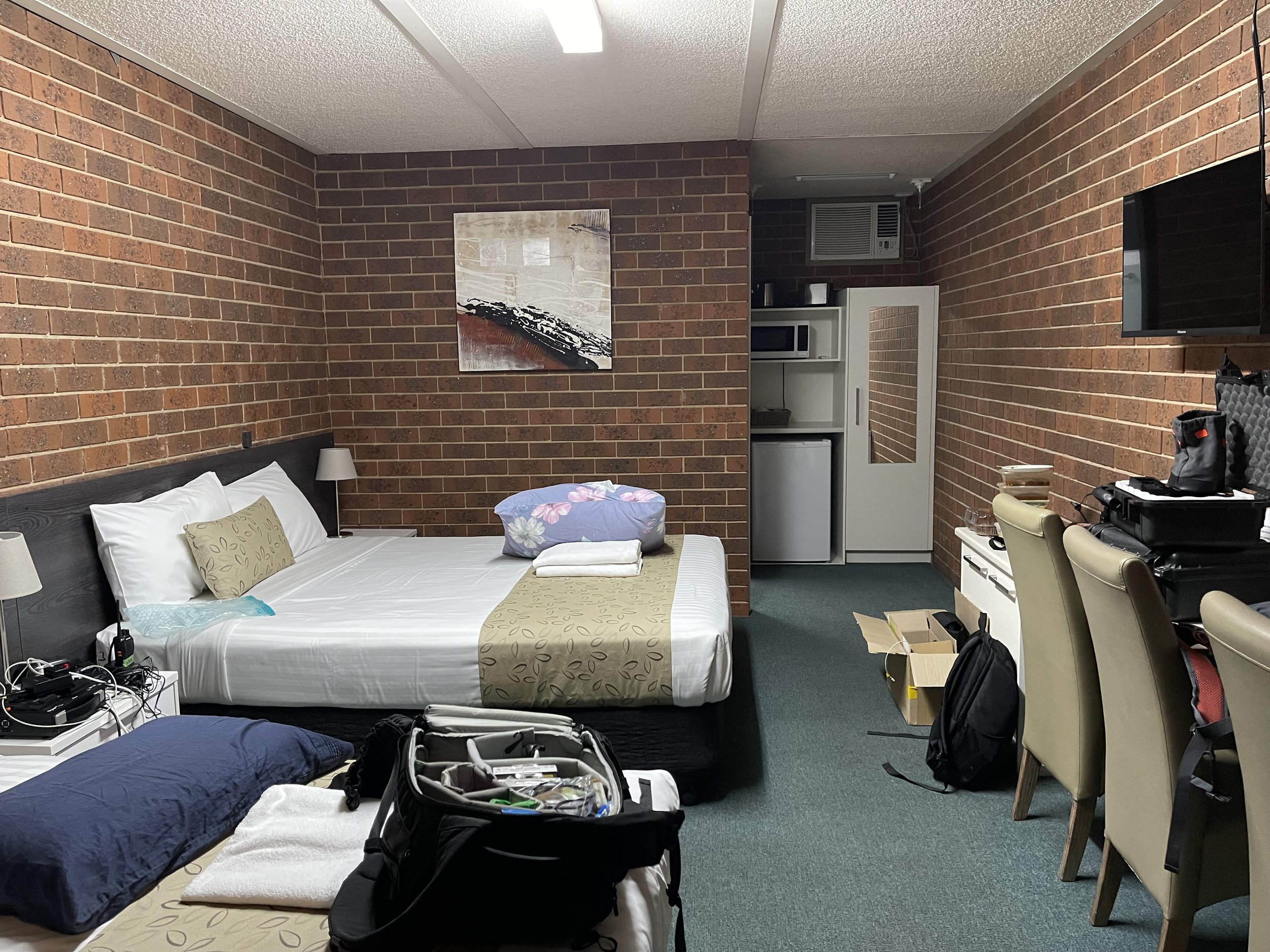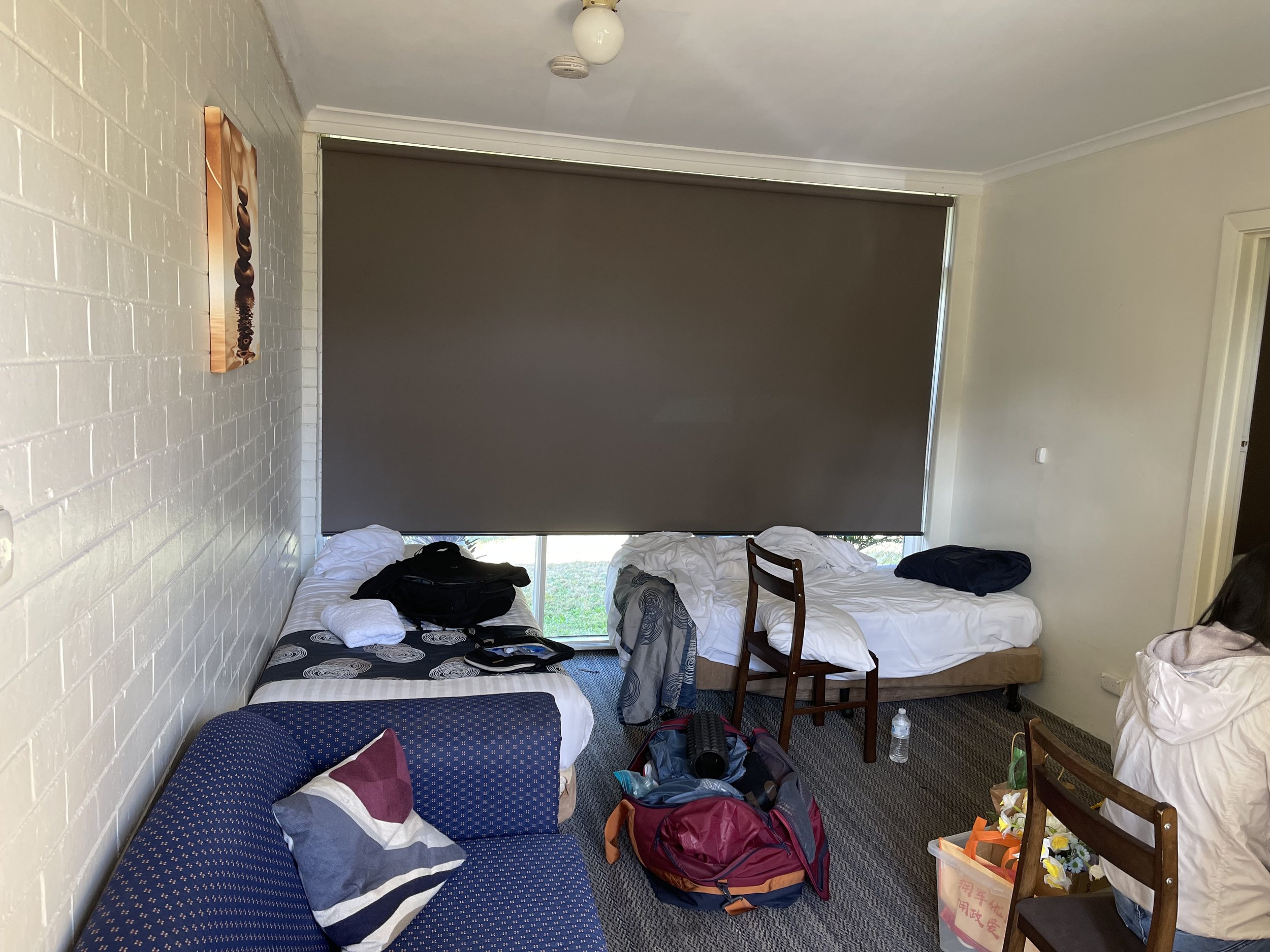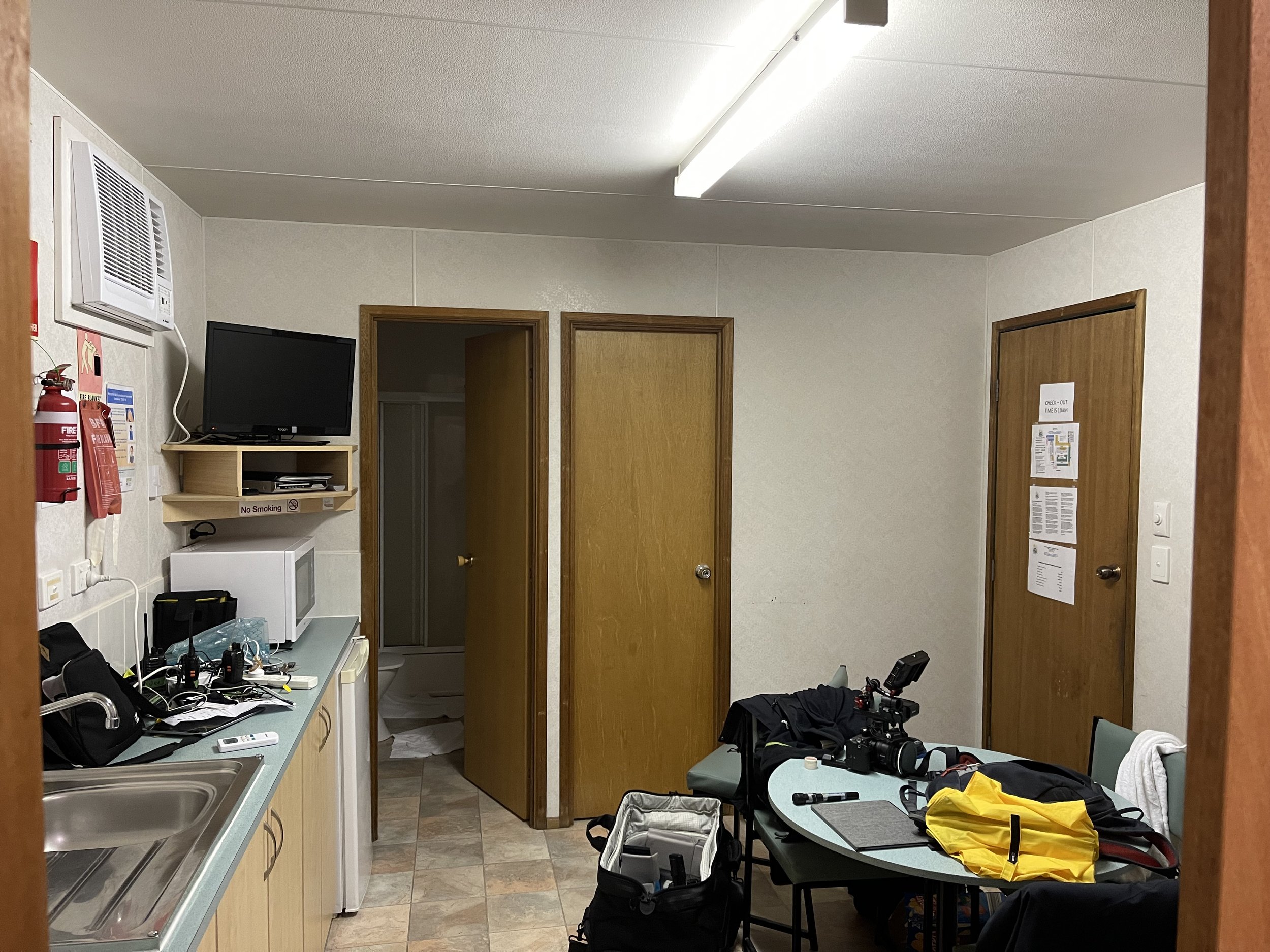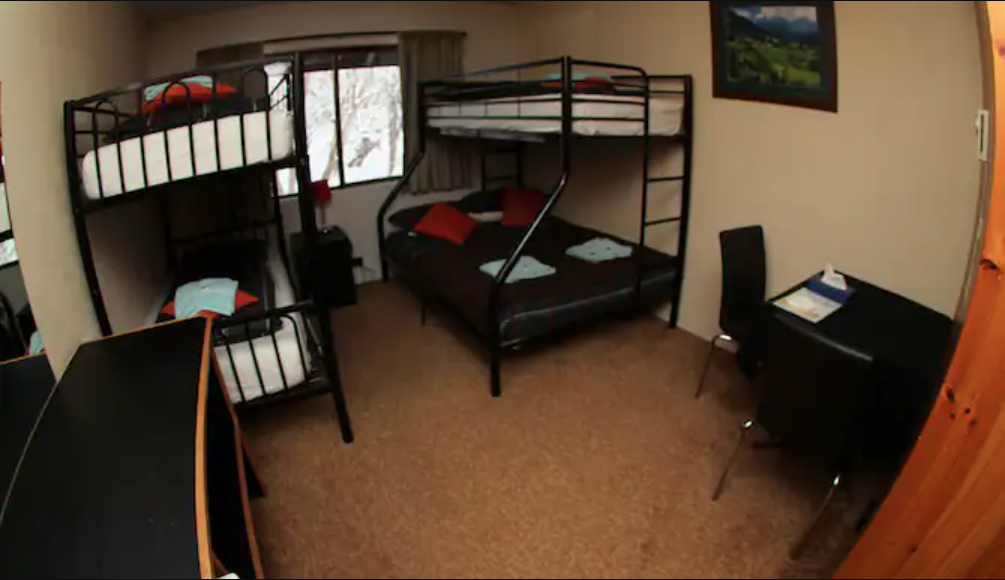AACTA Focus Pitch Winner - Jia
Jia is about a grieving Chinese mother who arrives in Australia to embark on a roadtrip with a young Caucasian man to remember a loved one.
It is a story of connecting two people from different backgrounds who are unable to communicate but share the same love of another.
Birth of an idea - 12 days - September 2021
When Vee first described an idea to me it was in Winter 2020 and he wanted to go back home to China to make a film using the mountainous landscapes and backdrops of rural China. During that year the Covid pandemic prevented him from making the trip back and so the idea was put on hold. A year later we discussed the idea of filming a 15 minute proof of concept (POC) here in Melbourne before he went back so that he could practice directing again. It was about 3 years since we filmed anything together and he was getting frustrated that he hadn't made a film since. During this whole time we had never considered external funding, we assumed we would be self-funding the POC as we had normally done in the past on previous projects. It was a stroke of luck that another director I knew, Caitlin Wong; reached out to me to join her in entering the AACTA focus pitch competition that I thought it would benefit Vee as well to start conceptualizing an idea to something more tangible. We had a 12 days before the deadline to come up with the entry requirements.
The inception for this idea is abit blurry for Vee. He remembers lying on the floor with a mask over his eyes (as he often does when he is thinking) and trying to think of something deeply personal and familiar. His mum popped into his head or more precisely, the feeling of a mother’s unconditional love. He started to wonder what it would be like for his mother if he was dead - and so the idea was birthed, from just a feeling.
The requirements were:
1. A Title - Jia (家)
The original title during development was 475 Miles but it was changed to Jia; which translates to “Home”, after the POC was completed because it gave a deeper meaning to the purpose of Ming’s journey.
2. Logline
Jia is about a grieving Chinese mother who arrives in Australia to embark on a roadtrip with a young Caucasian man to remember a loved one.
3. 500 word Synopsis
Jia 家 is a story about a Chinese mother in her late 50s, Ming, an English illiterate, who embarks on a road trip in rural Victoria with an unlikely companion, a Caucasian dancer, Eric. Throughout the road trip, we find out that Ming’s son, Yao, died in a road trip accident while travelling with Eric. Unable to cope with losing her only son, Ming travels from China to Australia to go on the same journey that Yao had been on with Eric before he died so that she could say goodbye.
But Ming discovers something about her son that she never expected - a romantic relationship with Eric, an unfathomable image for a conservative catholic mother who spent most of her life in a rural communist China. Confused, angry and bearing the insurmountable pain in her heart, Ming continues the journey with Eric. When she finally reaches her ‘destination, ’ she finds no relief from her grief. However, she does come to find a man who loves her son deeply and shares her pain. Knowing that Yao was with someone he loved during his last moments gives her a sliver of comfort.
4. A Pitch Video
5. Resumes
Round 2 (Top 10) - 2 weeks - October 2021
This next round consisted of the Top 10 entries nationwide. To my delight, Vee and Caitlin had both made it through. This time the requirements were to put together a Pitch Deck, 10 pages of Screenplay and a budget of the production in just 2 weeks. It was around this time that we also discussed how the film should look. A more indepth discussion about the approach is detailed below.
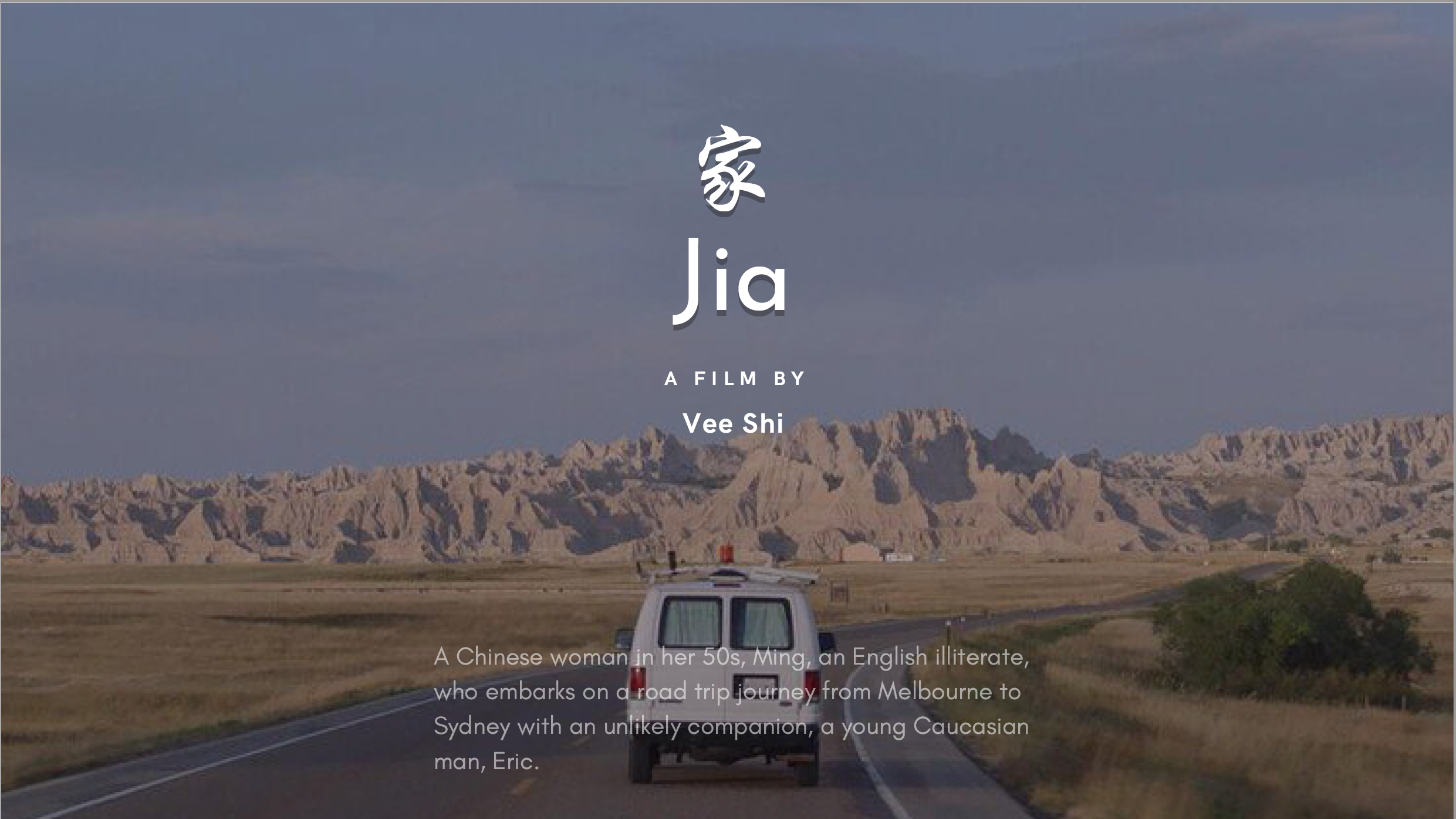
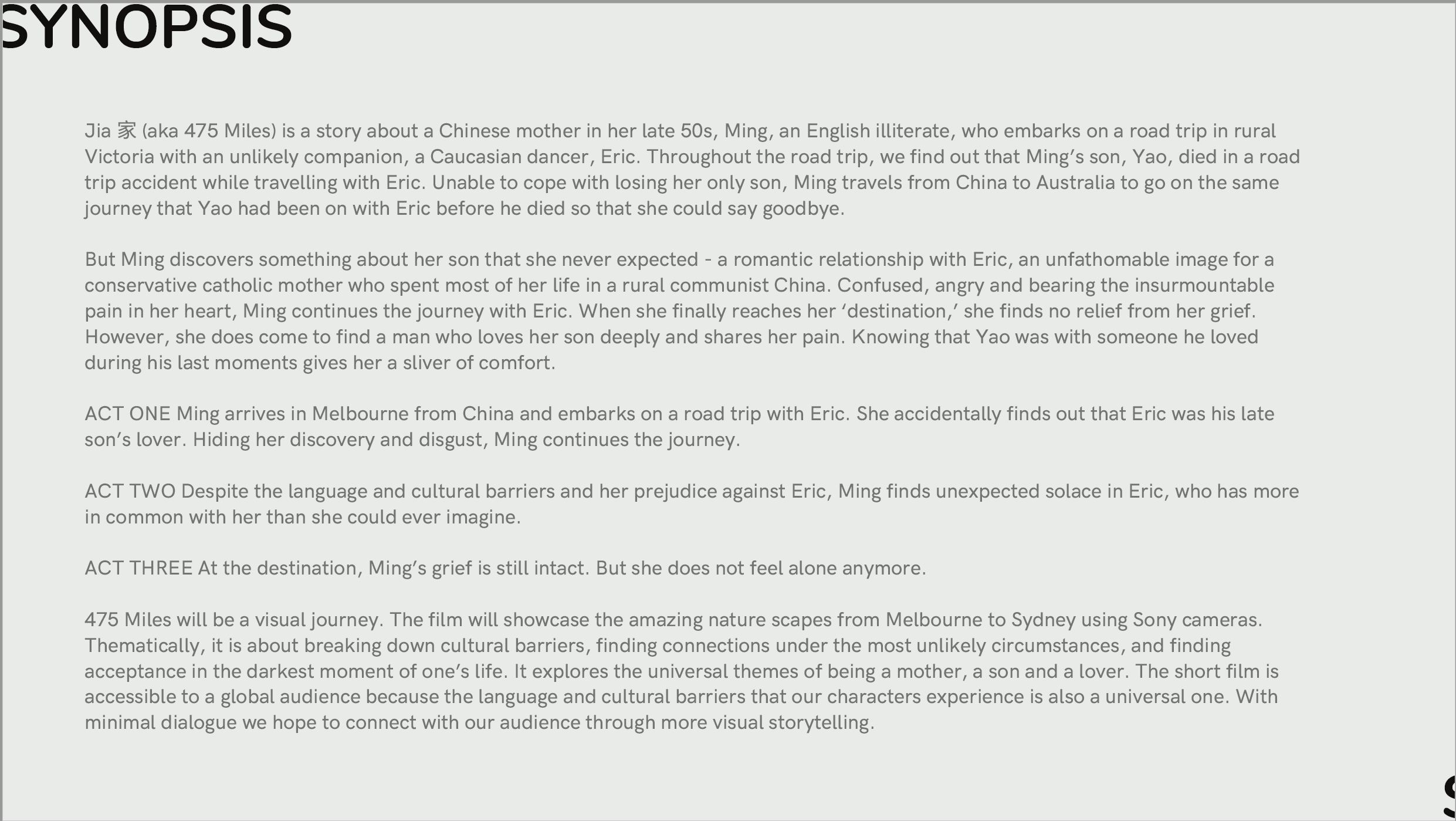
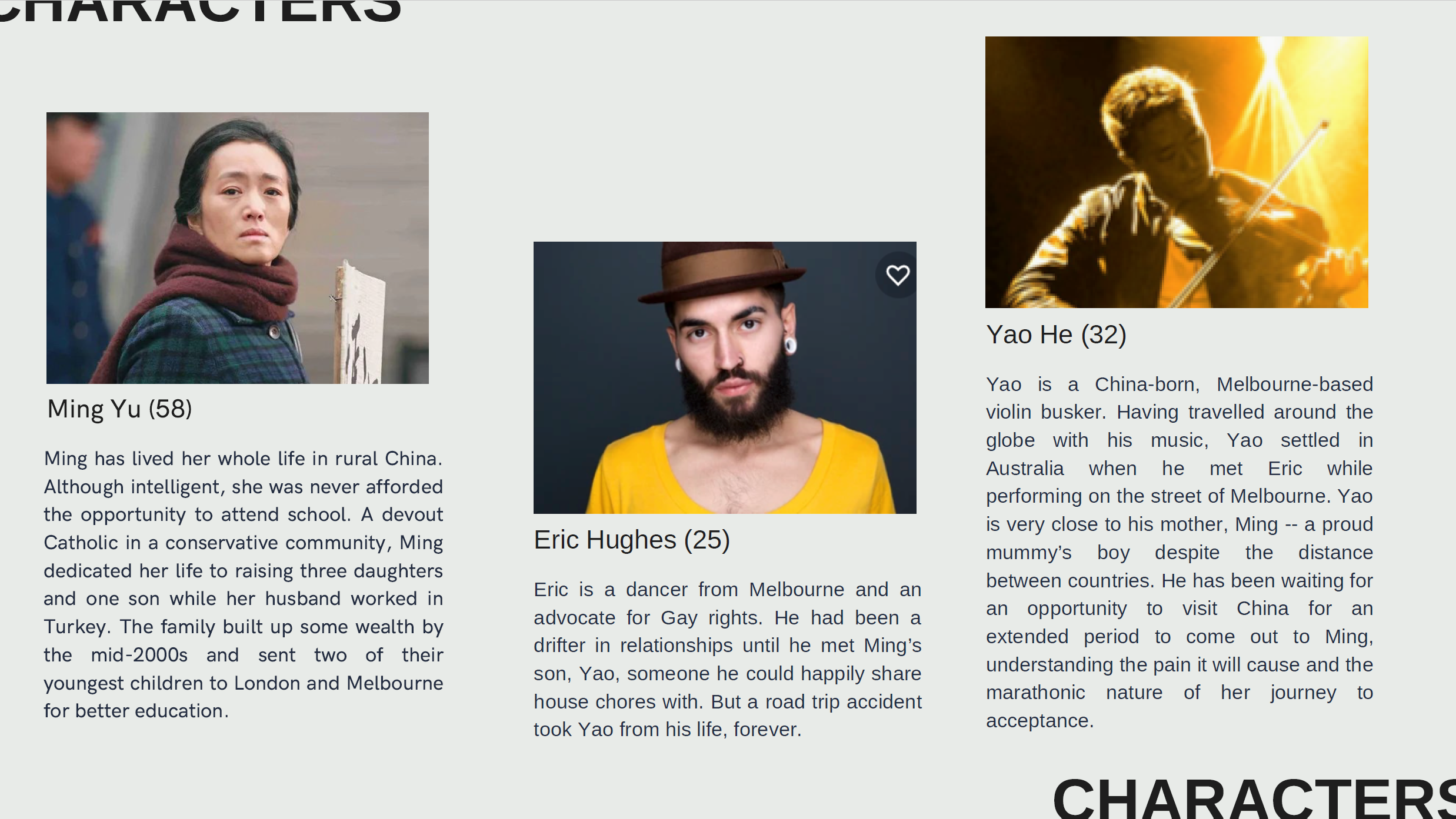
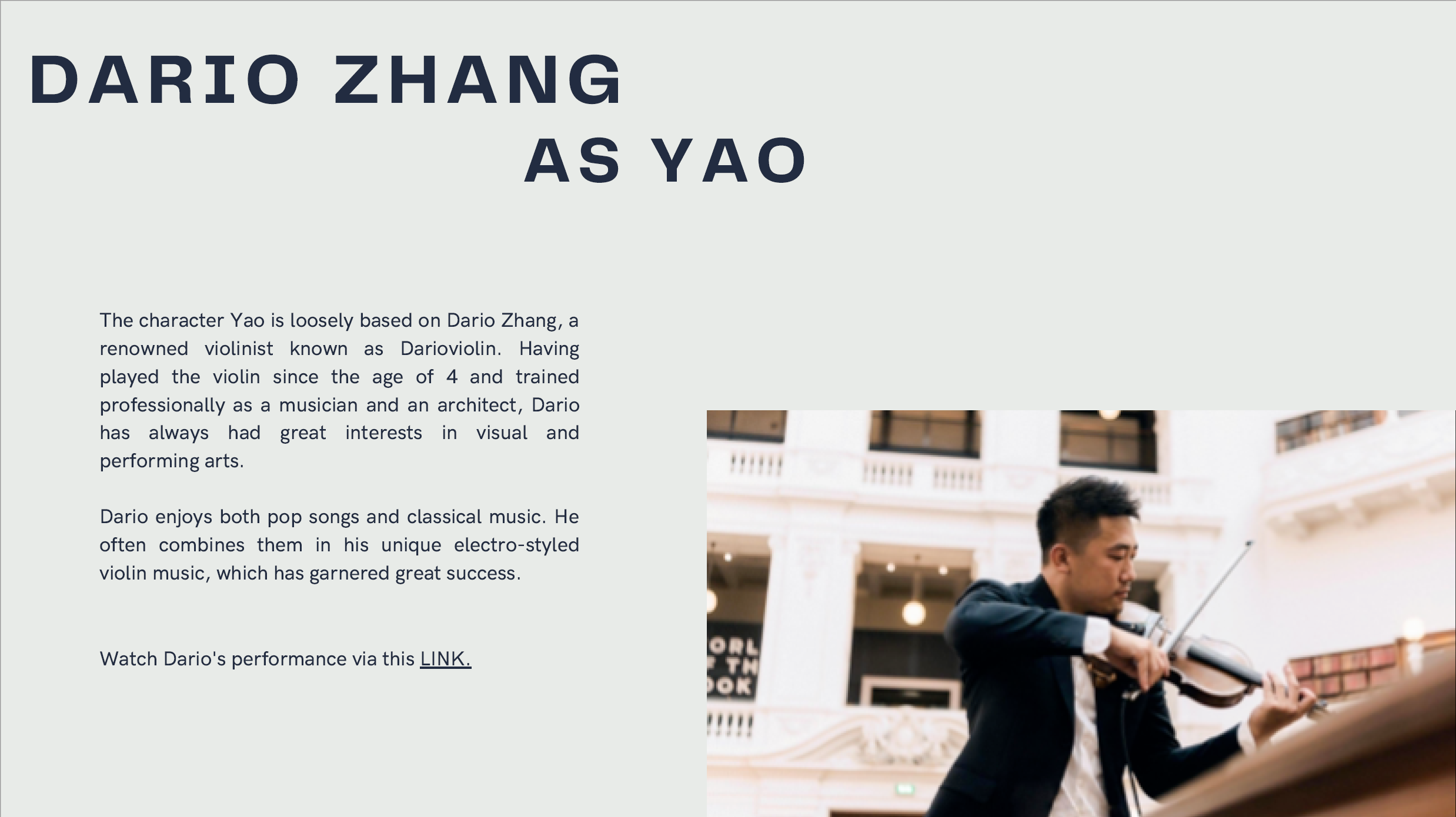
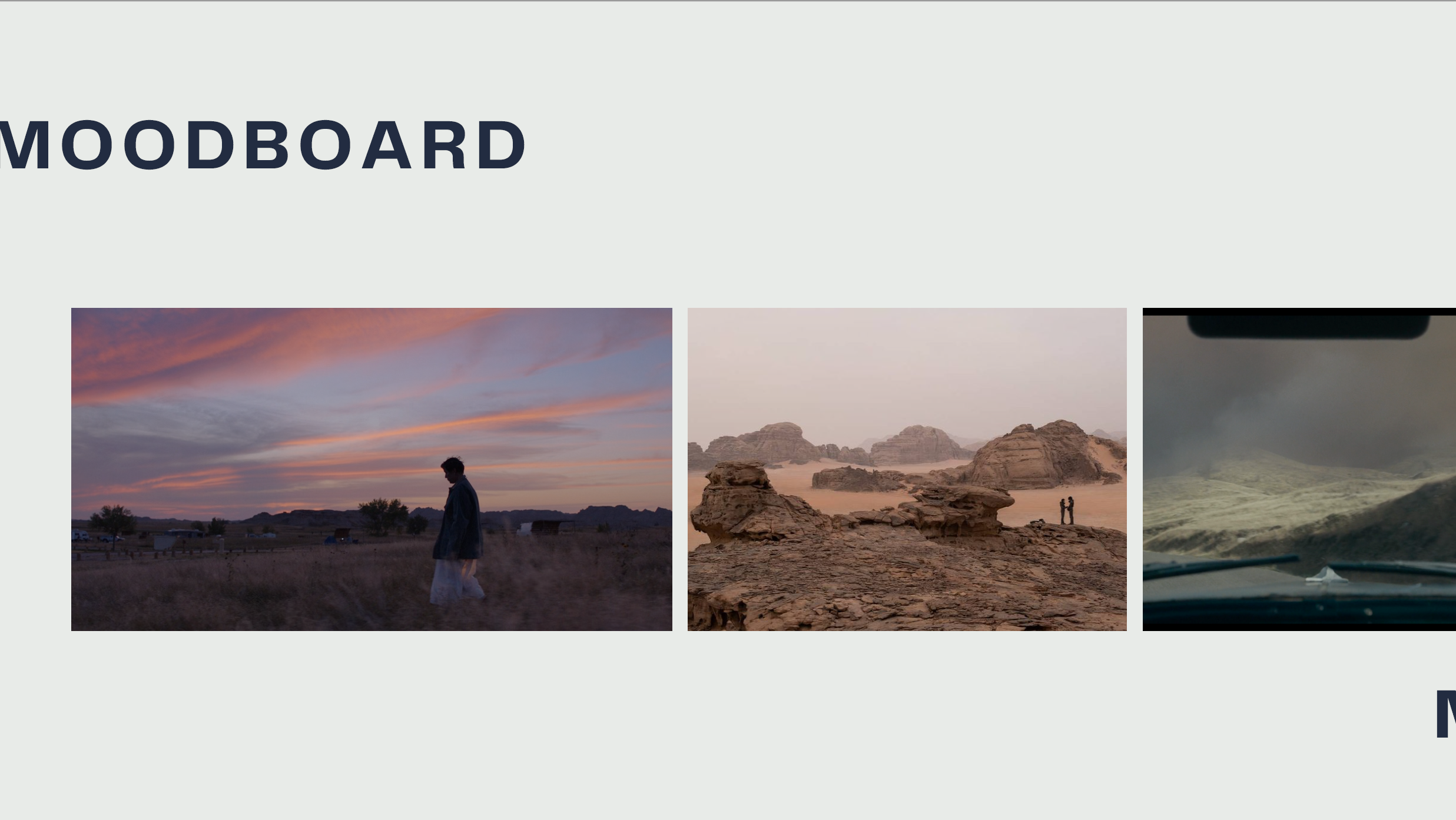
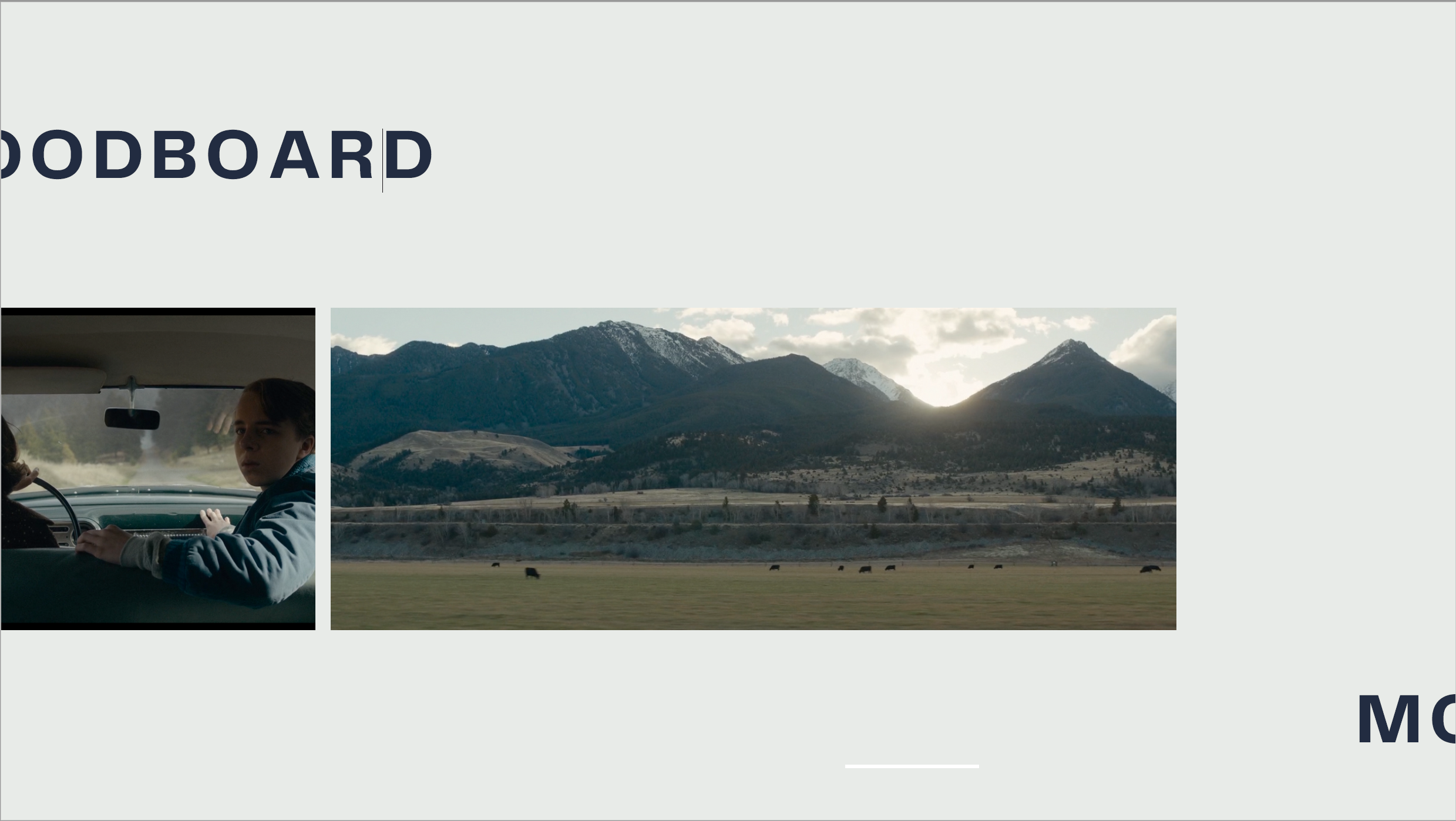
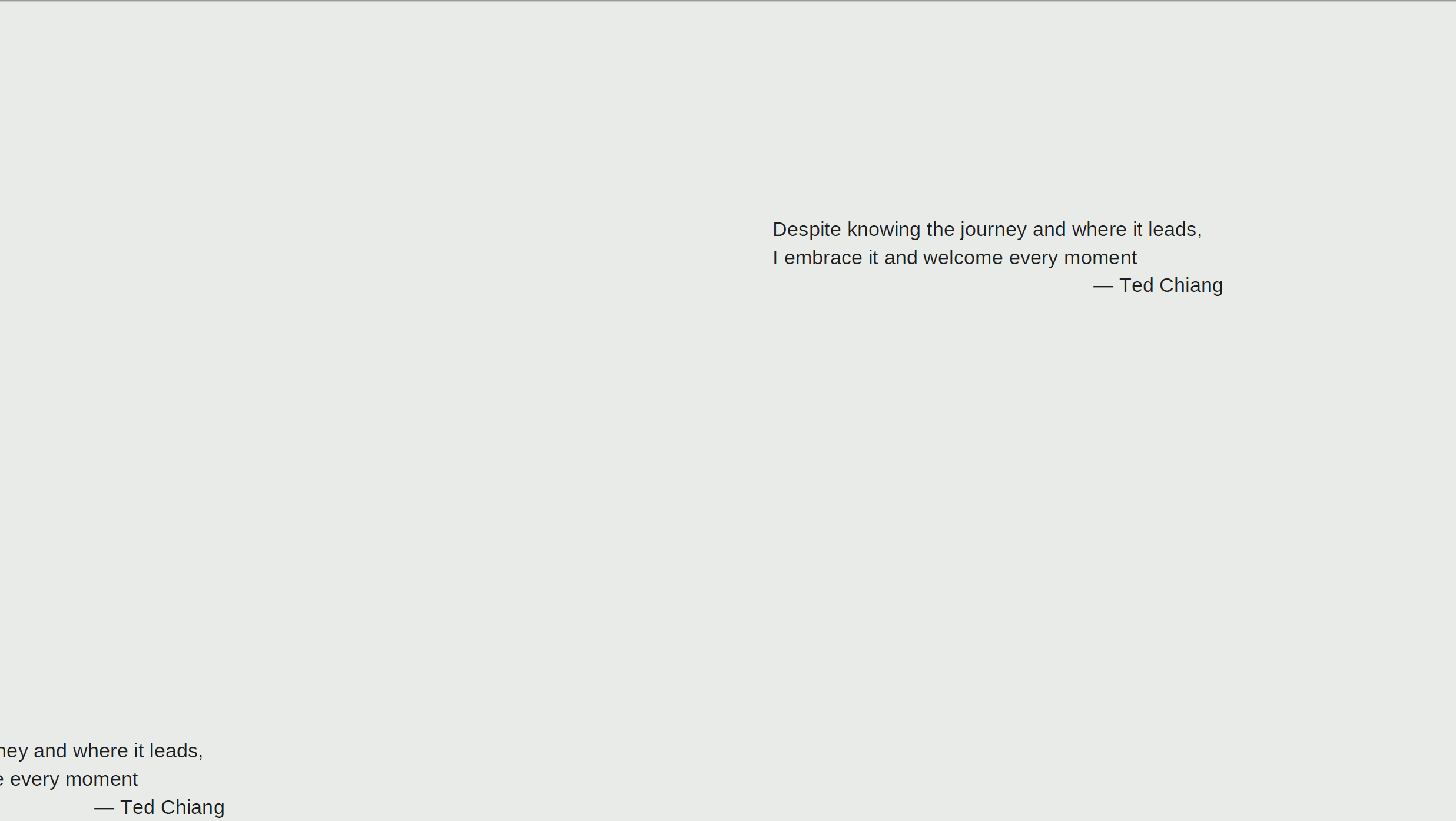
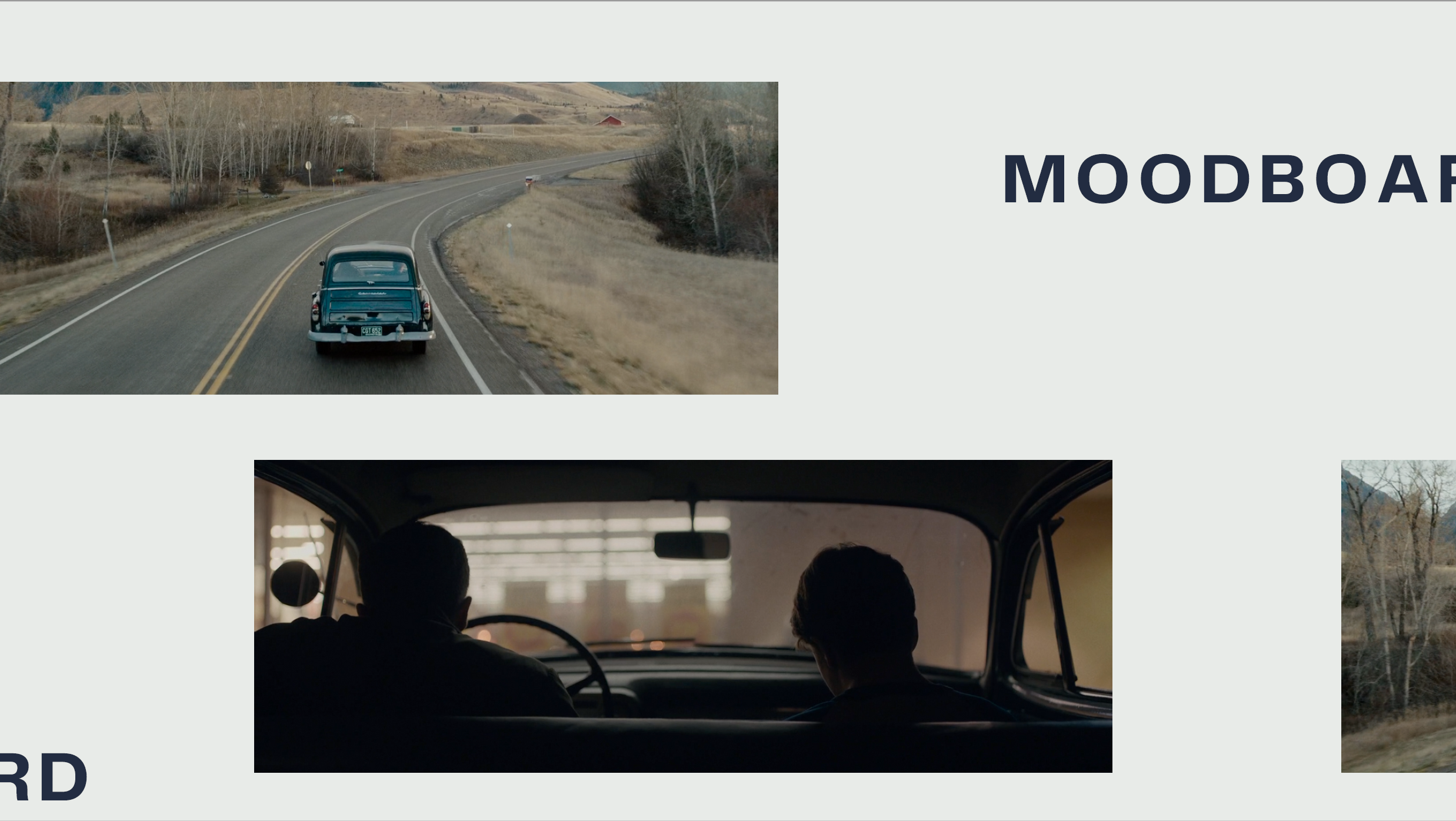
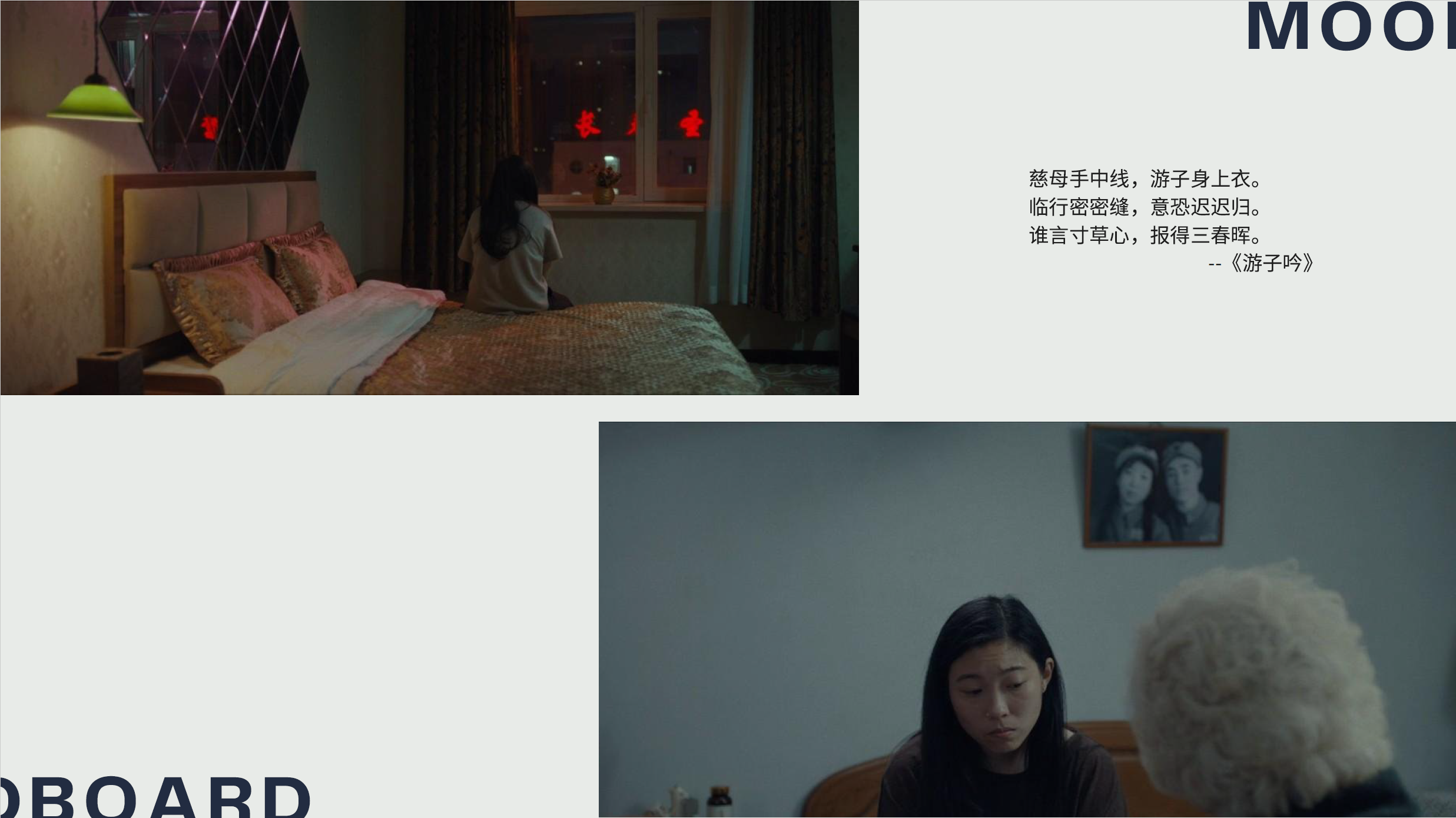

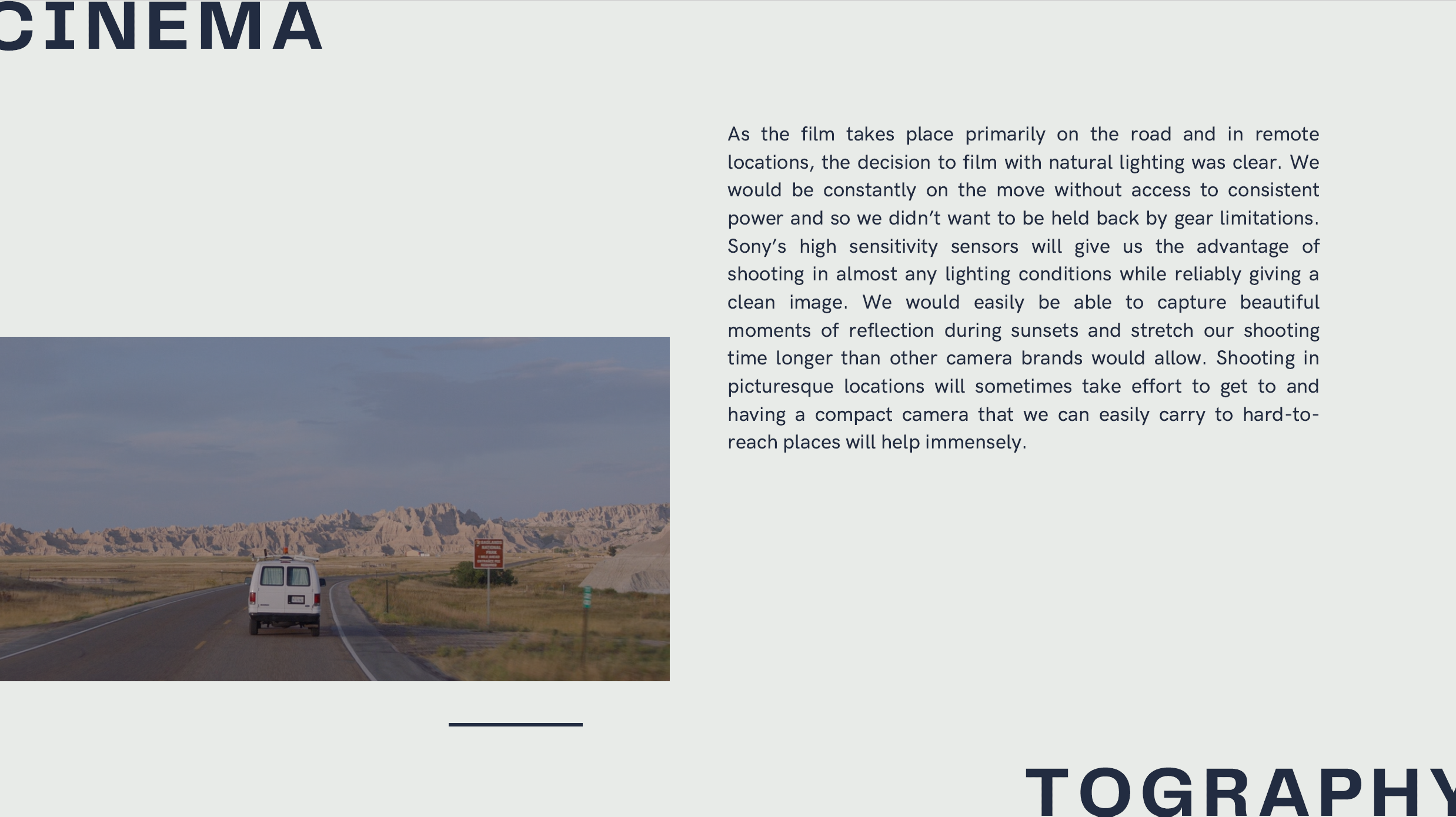
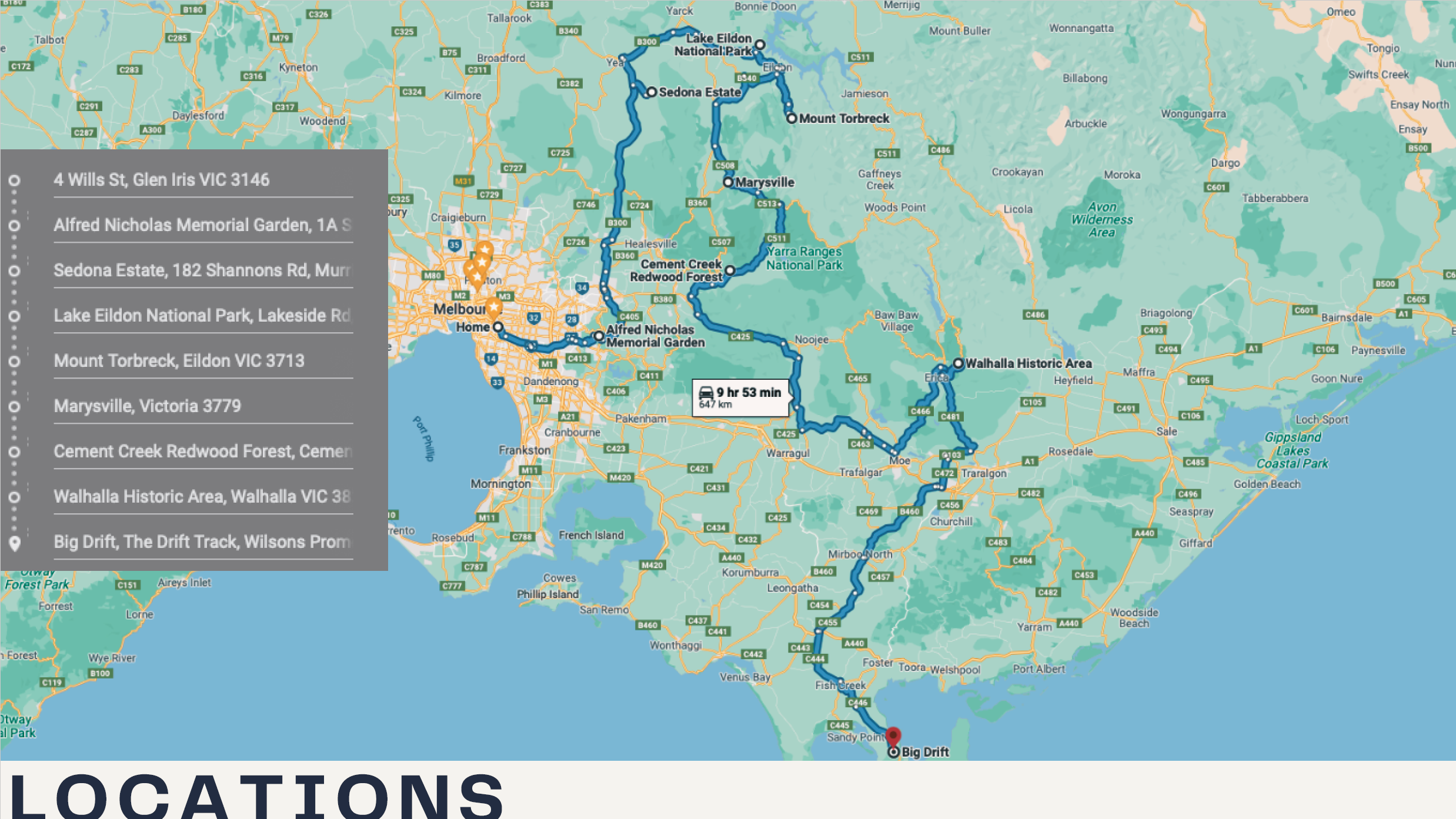

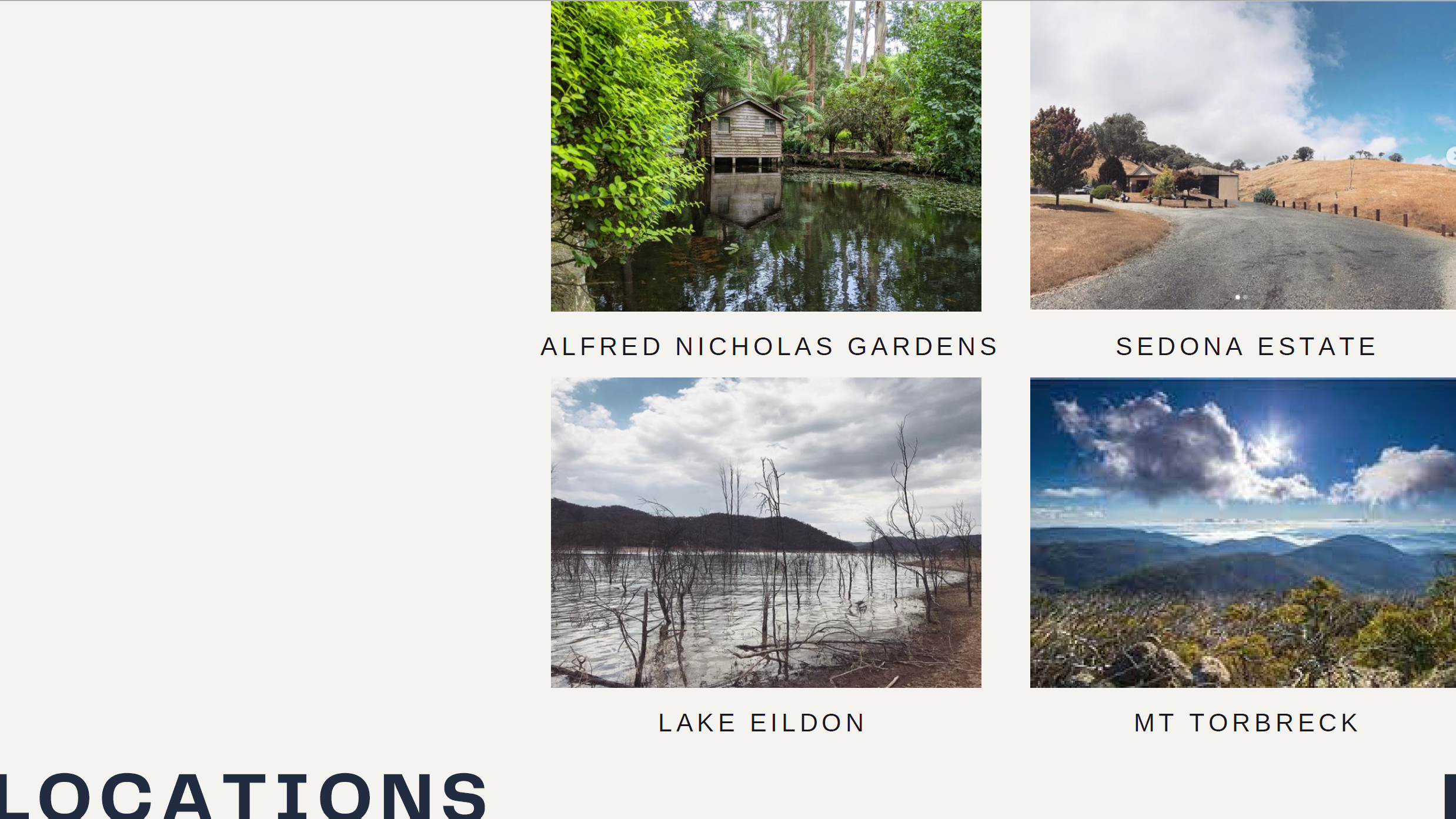
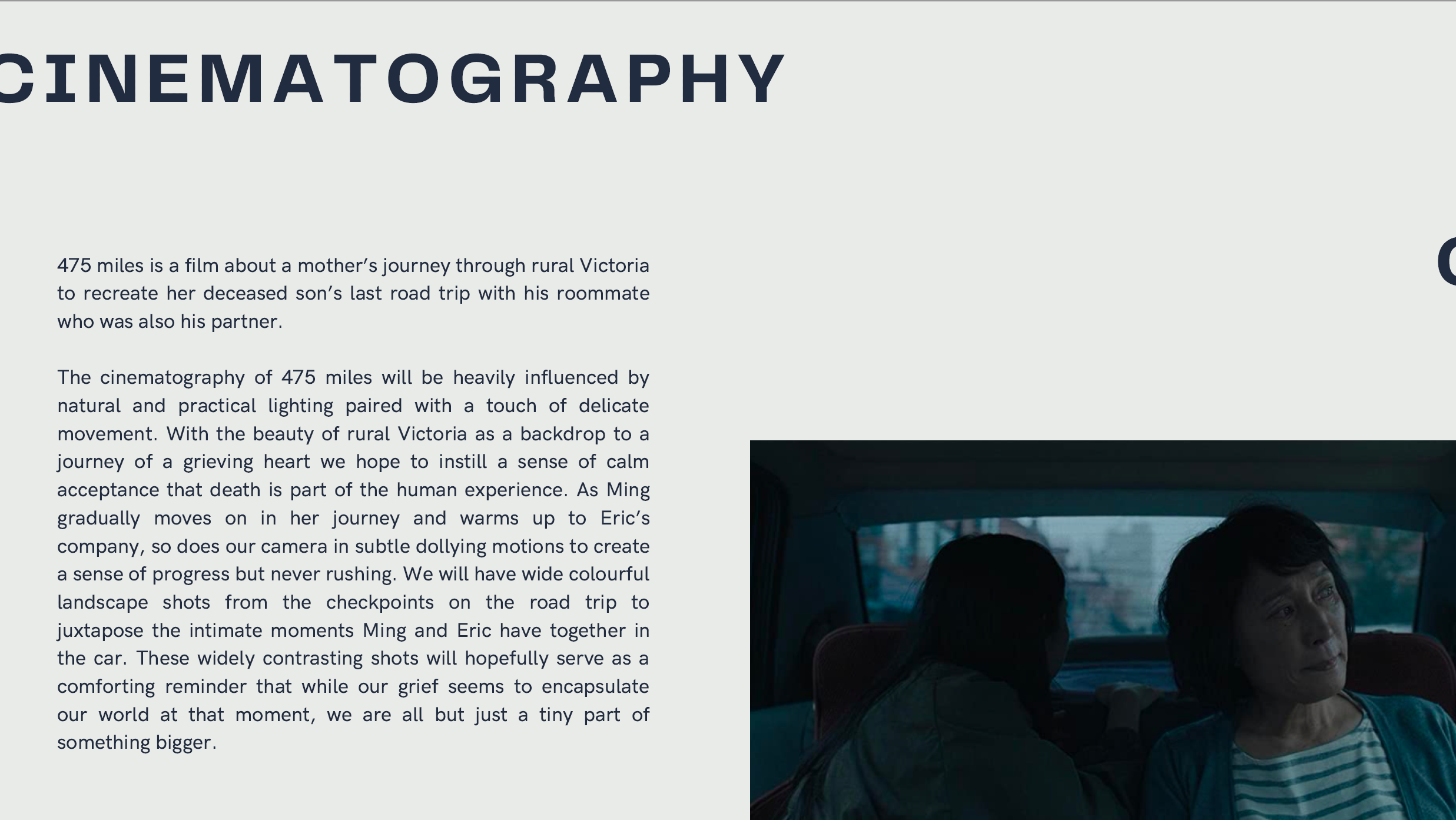
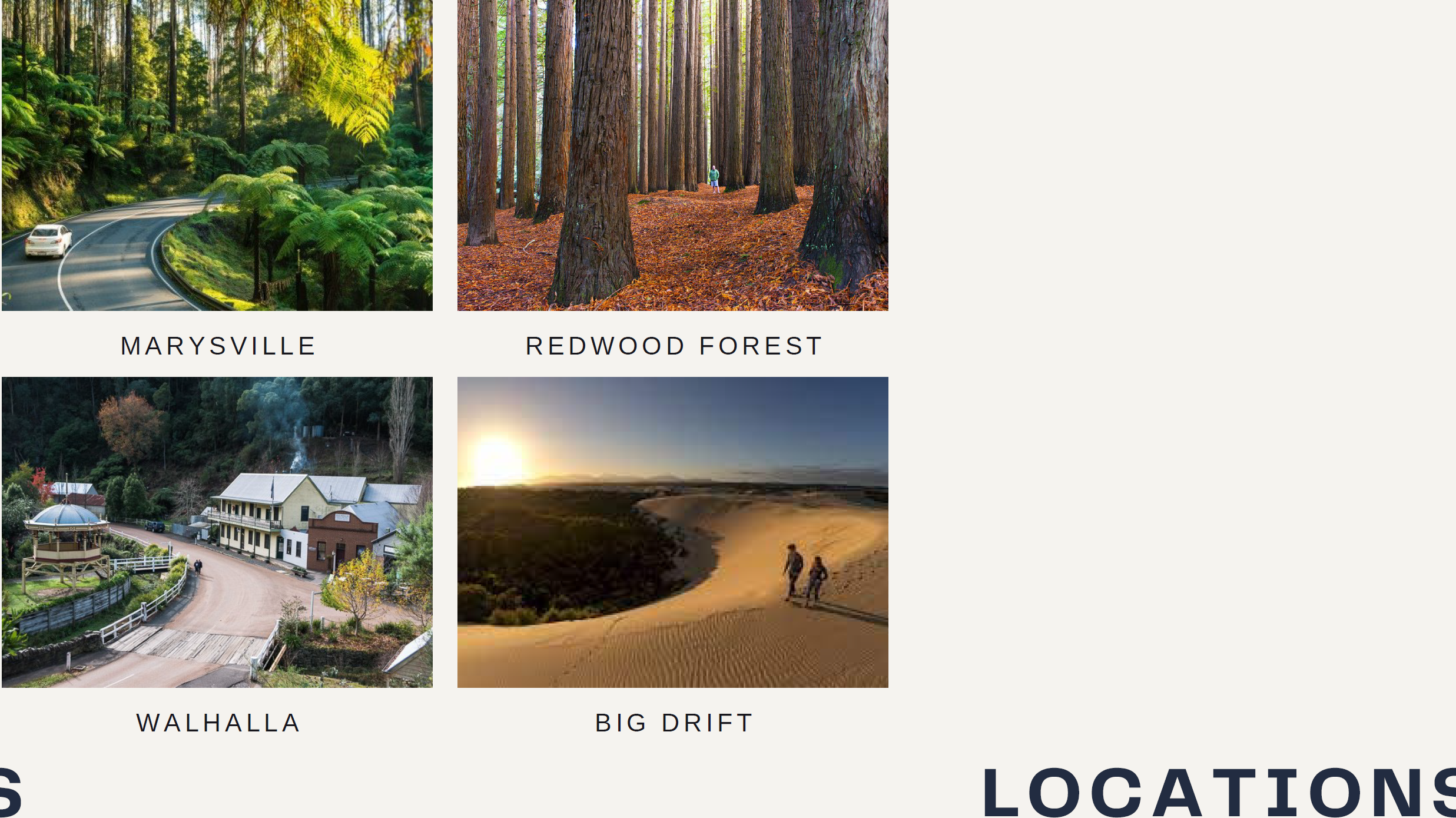



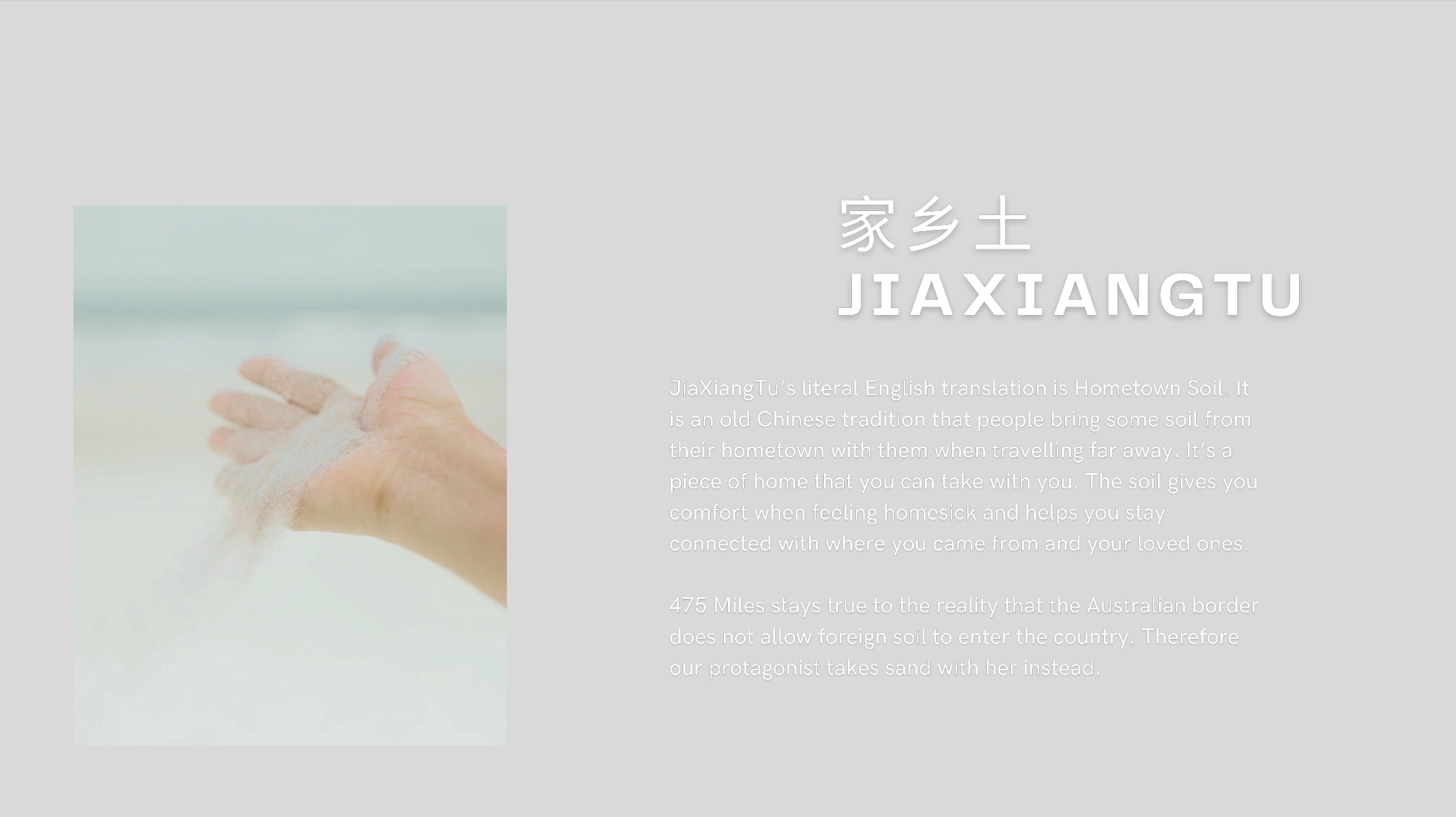

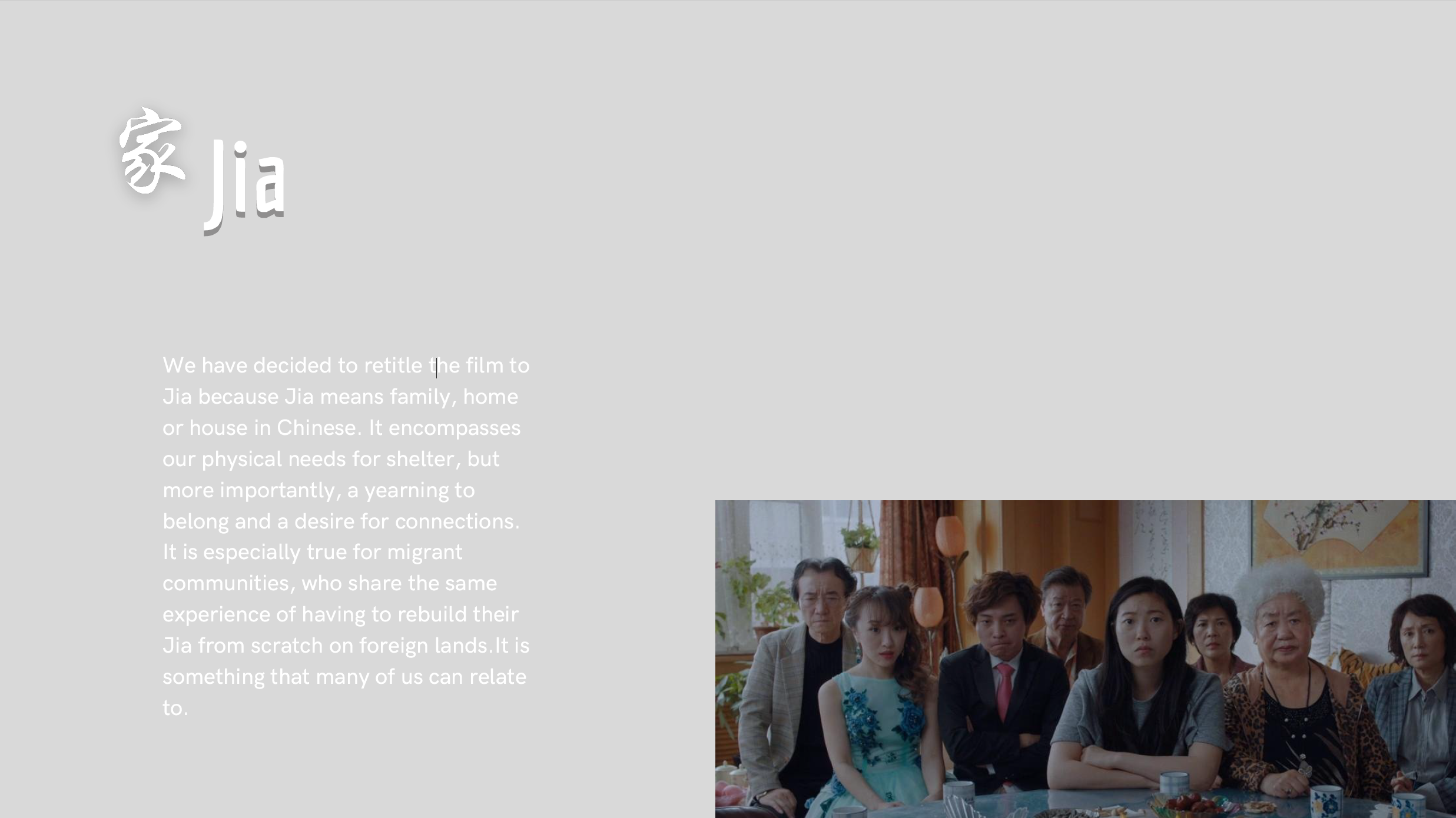



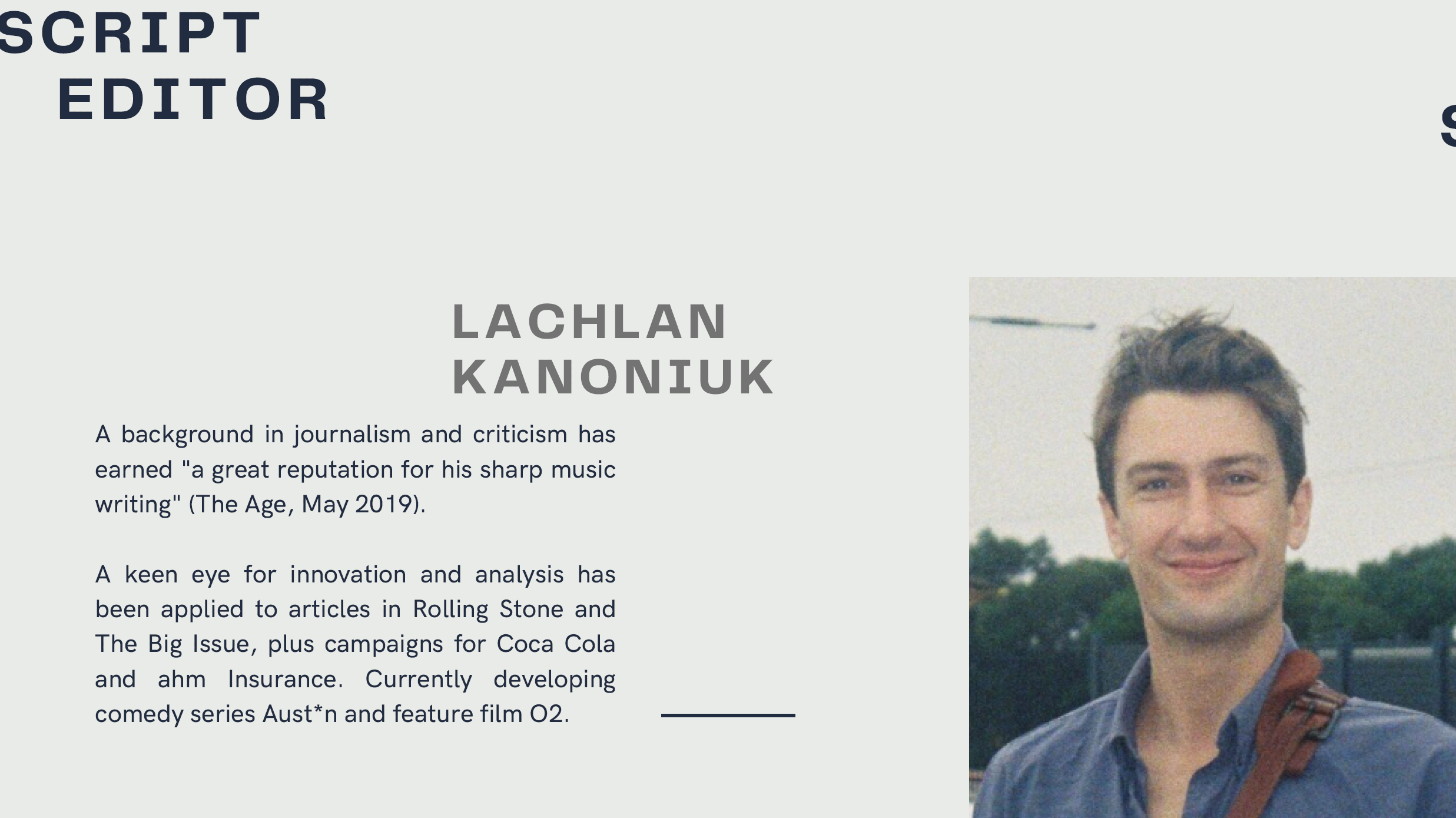

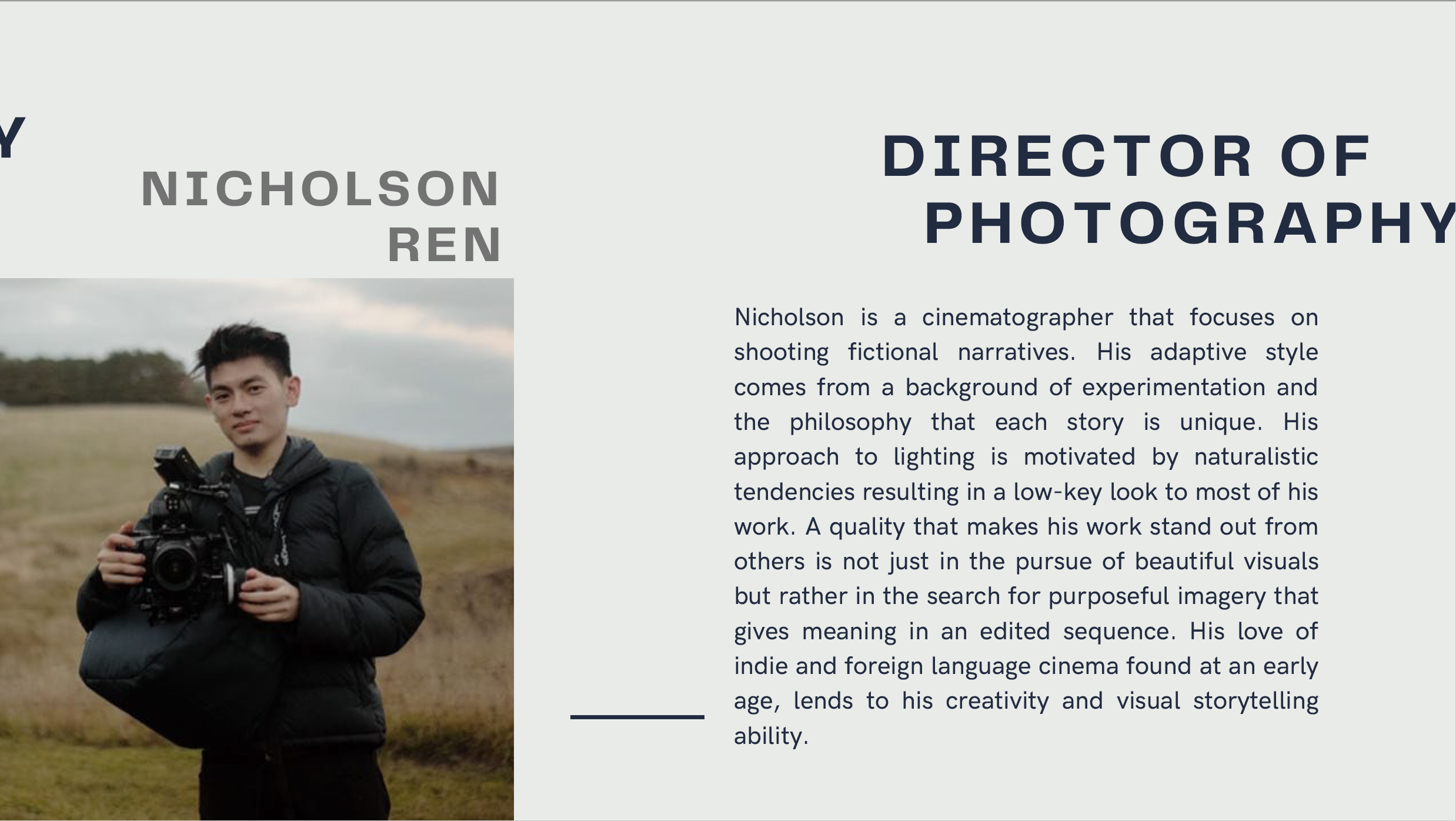

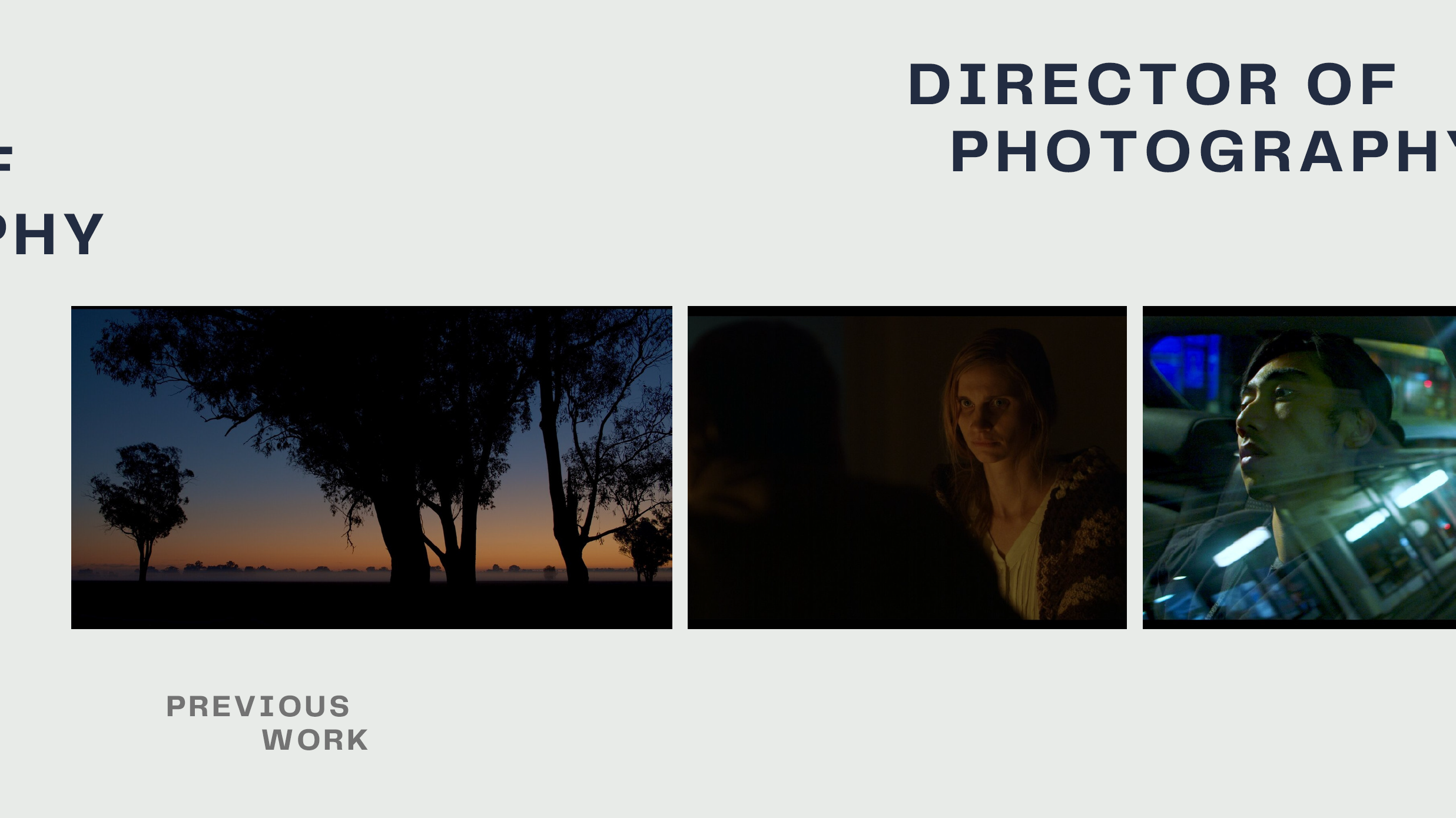
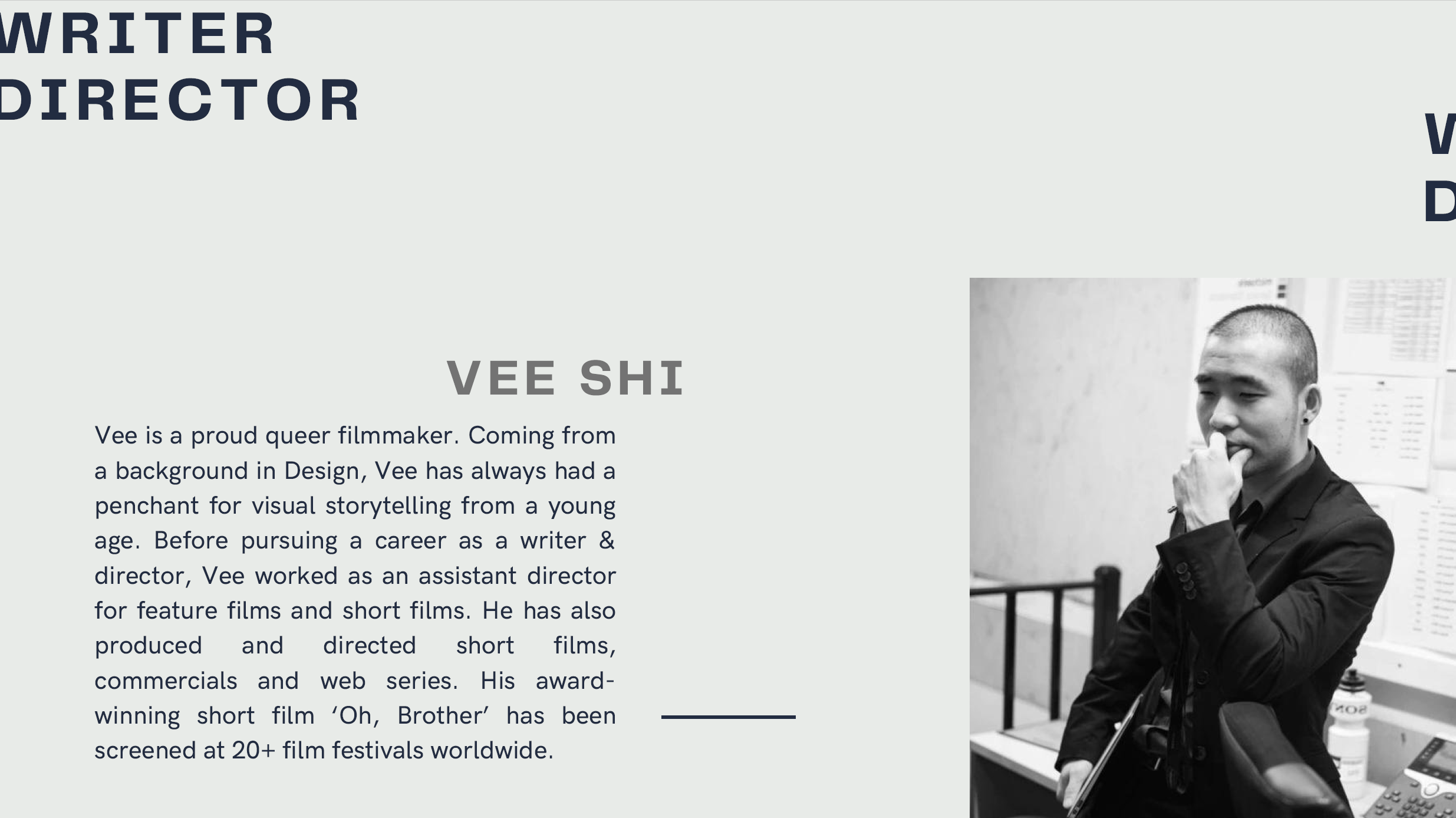
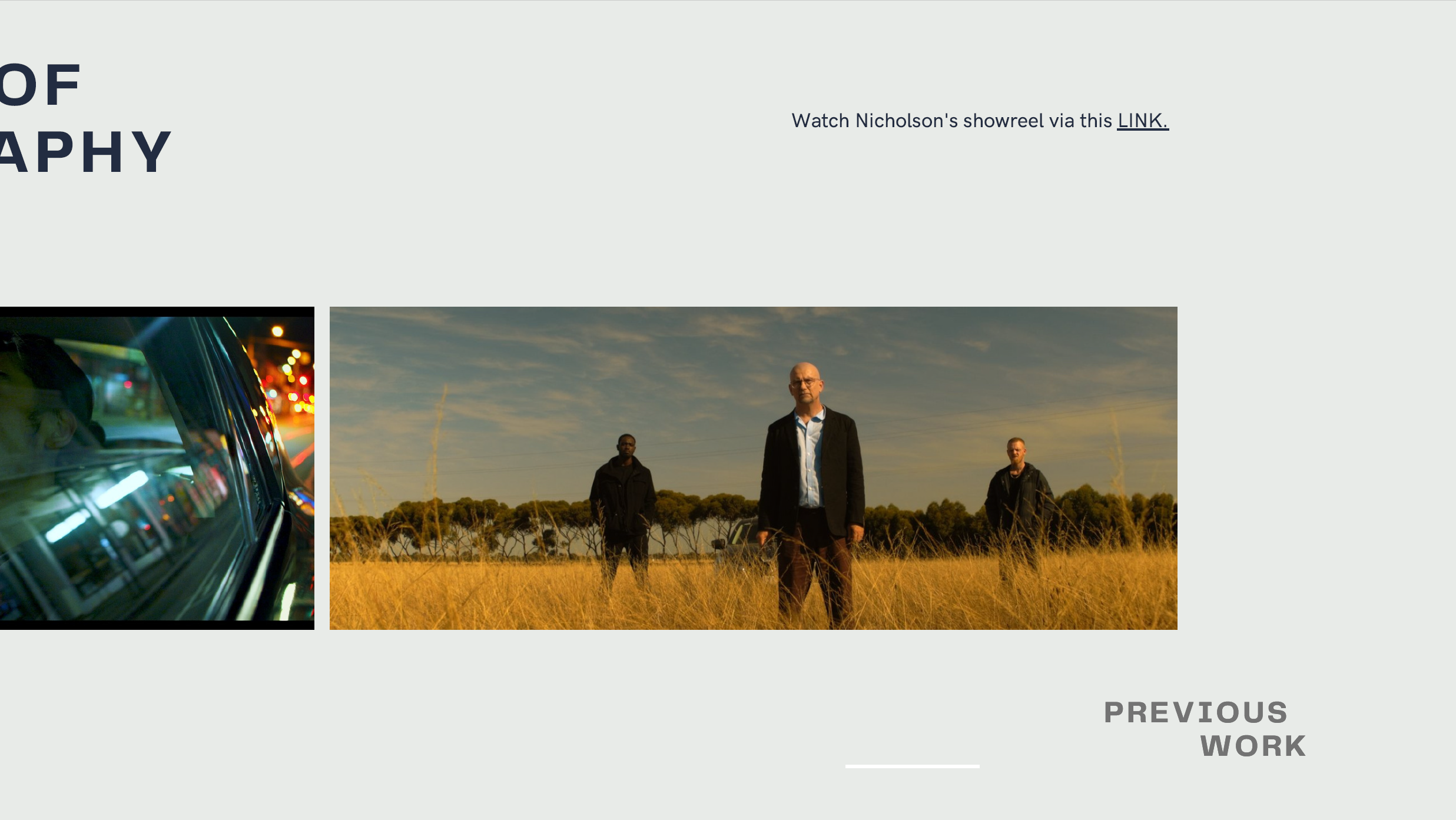

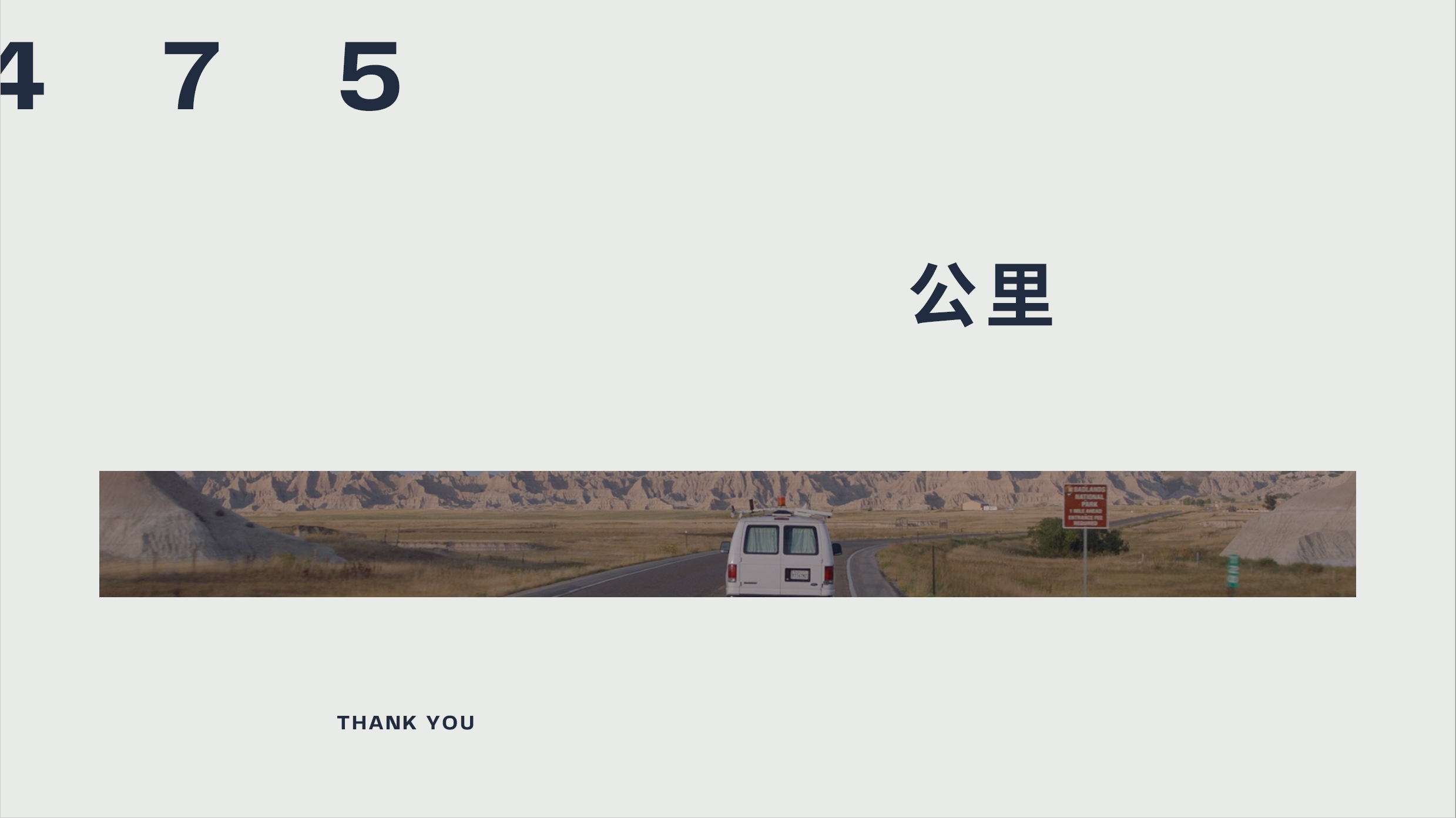




On the Cinematography of the film
“The cinematography of Jia will be heavily influenced by natural and practical lighting paired with a touch of delicate movement. With the beauty of rural Victoria as a backdrop to a journey of a grieving heart we hope to instill a sense of calm acceptance that death is part of the human experience. As Ming gradually moves on in her journey and warms up to Eric’s company, so does our camera in subtle dollying motions to create a sense of progress but never rushing. We will have wide colourful landscape shots from the checkpoints on the road trip to juxtapose the intimate moments Ming and Eric have together in the car. These widely contrasting shots will hopefully serve as a comforting reminder that while our grief seems to encapsulate our world at that moment, we are all but just a tiny part of something bigger.
The 2 films we referenced the most were Nomadland (2020) by Chloe Zhao and Still Life (2006) by Jia Zhangke. Both films were made in two different decades but it showed us that pure natural lighting can be used to great effect to tell engaging stories.
When discussing the look of the film we knew it would be partially influenced by the logistics. This would be a low budget film that would be taking place almost entirely outdoors and on locations. We’d be constantly on the road travelling through unknown environments and accommodations that we couldn’t guarantee would be film friendly. Our plan was to approach it like dogma or guerrilla filmmaking, catching scenes on the fly and improvising shots as we went along. Lighting design would be governed by what was available. We made a conscious choice to not spend any of the budget on lighting equipment and to take it a step further we did not bring any lighting equipment at all, not even a reflector. I was more comfortable with this challenge knowing that I would be using the Sony FX line of cameras paired with their fast G and GM lenses. Our crew was also going to be at the bare minimum to reduce the number of vehicles we needed to take and in turn the petrol fees on the budget.
There was no backup lighting equipment brought along, everything available to us was natural or whatever was already at the location. Our lighting design was simply selectively switching lights on or off as well as blocking according to the sun-path.
Our initial estimation of the budget was for 2 vehicles and 6 cast/crew members on the road for 5 days. For the actual shoot we had 3 vehicles and 8 cast/ crew members travelling for 7.5 days.
Estimated budget: $15,353
Final budget: $20,671
The final expenses were more than budgeted because we brought on more crew members especially during post-production and had multiple week-long pre-production trips. Festival submissions costs are not included in the final budget breakdown but I estimate that we spent a further $5000 in that area. A timeline of the whole production can be seen below. Each phase is detailed in this entry.
Proof of Concept (Top 5) - 10 days - November 2021
For this stage only 5 teams progressed. Caitlin's film did not get through and all my efforts was now focused on Jia. For this 3 minute POC, the first thing we had to decide on was what we wanted to film. Do we shoot a trailer of the whole story or do we show just a short scene to demonstrate our style? In the end, it was a small combination of both. We wanted to focus on our 2 main characters, the journey and backdrop being secondary to the relationship. We also wanted to show our key style - quiet lingering moments. It had to convey the right emotion and also prove that we were technically competent to execute the idea.
Vee chose the dream sequence to be our scene. It’s a key moment in the film when the mother, dreaming of her son, realises that the person travelling with her is also grieving a loved one. We experience the rawness of the mother's grief and her realisation that she is not alone. This sequence was also re-edited into the final film.
We only had 10 days to prepare, film and submit our POC. The first 5 days were spent on solving logistical challenges.
- Aligning cast and crew availabilities: Our lead actress Sel Hiew was based in Sydney, we flew her down to Melbourne for the day and as Tyler was unavailable during this period, we had our friend Tristan Braines step in to play the role of Eric instead. In total there were 5 of us including Chris our sound recordist that were involved on the shoot day.
- Collect/ rent equipment: On this particular week there was a delivery strike in Melbourne and we had to go to the airport ourselves to pick up the package from Sony. We also rented extra equipment to make the shoot more efficient and to get the look we wanted.
- Sourcing locations: Our planned locations were at Kokoda Memorial Trail and a quiet grassy side road in Cardinia.
All costs for this POC were also self-funded by Vee and myself.
Our lightweight camera rig for the POC
To film the POC - Sony shipped down a small equipment package for us to use. It consisted of an FX3, a top handle and the Sony 24-105mm F/4 G OSS lens. To complement the package we rented an Atomos Ninja V and the 25mm Zeiss Batis F1.8. We chose this lens because we wanted to keep a wider FOV to show our character in the landscapes even for closeups and the fast speed would allow us to shoot in lower light than the F4 lens provided. Additionally, because we were handheld for the most part a prime lens would keep the weight and size of the rig down.
The POC was filmed in 1 day and it was the first time I had used this camera and we were pleasantly surprised by it's compactness and versatility. In fact, the entire POC was unconventionally shot at 12800 ISO together with a VND to control the exposure. There was no shot-list or pre-vis ideas on what the POC was going to look like. Everything was improvised except for the scene when Ming runs out of the car. The opening of the sequence was actually found by accident, we were travelling between locations and decided to stop as we had driven through some fog. There was a small trail next to the intersection we stopped at and we decided to venture down to look. The location was off-trail and we had to walk through some bushes to get to it but for the purpose and look of a dream sequence it was a case of being in the right place at the right time when we weren't looking for it. The same conditions repeated themselves during the shoot while we were driving back down a mountain at night.
On Dec 4th Jia was announced as the winner of the AACTA Focus Pitch competition and we attended the 2021 AACTA awards ceremony in Sydney.
Pre-Production - The first of 3 Road trips
Location Scouting 15-16 Jan
After the excitement of attending our first red carpet event preparations to begin scouting were made. Vee went on a 3-day road trip with his partner in early Jan, a holiday that was also intended to be research for locations. It was important to us that the locations were achievable and the route made sense as a road trip to add a layer of realism to the story. The first proper location scout occurred over 2 days on 15th and 16th January. The purpose of this trip was to also get polaroids of Eric and Yao on their road trip to be used as props in the final film. It also gave us an idea about what type of accommodation we’d need, how busy each location was going to be and what the potential schedule could look like. Just driving straight through all the locations took about 7 hours each day and we spent less than an hour at each spot. We wanted to see what was on offer and match each location to the character’s journey to see which was the most suitable at each beat. About half the locations we went to on this first trip did not make it into the final film.
Map of the journey over 2 days for the scout
Day 1
1. Alfred Nicholas Memorial Garden
2. Cement Creek Redwood Forest
3. Foggs Lookout
4. Eildon Pondage Point lookout
5. Lake Mountain Summit
Day 2
6. Walhalla Goldfields Railway
7. Walhalla Historic Area
8. Den of Nargun
9. Big Drift
Tech Scouting 23-26 Feb
After the location scout, we knew we had to do another trip before the shoot. There would be multiple objectives for this next trip in order to help lighten the load during shooting week.
To look for other locations we potentially missed. Our climax scene originally set at Lake Mountain Summit didn’t give us the view we needed.
To block and shoot scenes using stand-ins to get a rough idea of structure and timing.
To film exterior driving shots of the car within the Victorian landscape.
Test the camera equipment loaned to us by Sony and to see if we needed to get anything else.
The tech scout resembled the location scout by all means except for a reduced number of people and extra camera equipment. What I discovered on this occasion was that the style of shooting we were going to do resembled documentary filmmaking. There were times when we would have to film moments not knowing how or if they would be used. I had to develop a constant mindset and be reminded not to rationalize the edit while we were on this discovery phase. It was a different style of filmmaking that at the time I was not very used to. We had 2 cameras - the FX3 and FX6, each built and ready to be taken out at any time. For longer scenes scheduled locations the FX6 would be the main camera on a Tripod or Handheld with my bebop saddle. Anything spontaneous in a public space or rigged to the car, the FX3 was used as it was smaller and lighter.
We brought along two people, my camera assistant Sam Vella and Derek Ho, a friend of Vee’s to act as the stand-ins and help with blocking the scenes. They drove the prop car as we filmed it from all angles within the Victorian landscape and were very patient with us as we stopped multiple times to film scenes and discuss the best approach. We pretty much filmed a very rough version of the whole script which assisted with redrafts and pacing discussions for the final shoot. We originally felt the approach we were going for was more suited for a feature film than a short which our test proved. The 4th draft became our shooting script after changes from the tech scout and script notes from Vee’s mentor, Tony Ayres.
Another benefit of these 4 days was the opportunity to test the camera’s in the same environment and workflow that we were going to use them on the real shoot. I go into a more in-depth discussion about the equipment we used below.
The 2 cars on the Tech Scout road trip. The Mazda (left) carried all the camera equipment and soft luggage while the prop car held all the food and essentials for the trip.
We wanted the tone and style of Jia to have an art house sensibility to it. The slow progression of our main character Ming to accepting the loss of her only child as well as discovering that Eric was his partner, will be reflected in the pacing and duration of our shots. We want to play with lingering moments in times of distress and reflection, and also complement them with subtle moving dolly shots that symbolise progression. Ming is always moving forward, no matter how long it takes her to accept it.
~ On Tone and Style from the Pitch Document
Equipment
The main pieces of equipment were as follows:
Camera bodies: Sony FX6 + Sony FX3
Lenses: Sony 20mm F1.8, Sony 24mm F1.4, Sony 35mm F1.4
Monitor: 5” Atomos Ninja V
Tripod: Cartoni Focus 8
Monitor+ App with the FX3
We chose just 3 wide prime focal lengths because we wanted to always see the character’s in their surroundings. Our aspect ratio of 2.35:1 complemented the wide landscapes and the beautiful scenery of Victoria that we wanted to show off. Even during intimate moments, we wanted to be able to see the background. The 24mm was the main focal length for the whole shoot.
Sony’s cameras were probably the only cameras we could have used for this shoot. Their functionality and purpose suited our production perfectly. With an almost documentary-like approach we needed to be able to shoot in all light conditions without hesitation. The FX6 with it’s dual ISO settings and electronic VND covered all our shooting scenarios. We used an ISO of 640 for all exteriors and interiors, occasionally bumping to 12800 when shooting inside the car. There were occasional over heating issues with the FX3 while shooting in sunnier situations but it didn’t hold us up.
One of the most useful features we utilised was the wireless app monitoring capability through the Monitor+ App for the cameras. Having the ability to easily monitor the camera live, playback through an ipad and download proxy footage straight to the ipad saved us alot of time.
With this function, we were able to mount the FX3 in it’s most basic form without additional equipment to a car mount inside and outside the car with minimal trouble. Vee was able to review rushes and edit the film on his iPad at night, which informed our shoot the next day and sometimes called for a reshoot.
Car Mount - Camtree G51 Car mount
We were greatly inspired by the travelling shots within Nomadland to frame our character’s within the moving landscape. It was also meant to be a recurring theme to juxtapose the intimate moments with the vast scenery to reflect the relative scale of our grief in this world. Unfortunately, none of the exterior shots done during the tech scout and production week made it into the final cut of the film as we felt that it interrupted the emotion and flow of the story.
In our first exterior driving attempt we discovered that the car's movements caused the lens to bounce quite vigorously. To fix this we used small miscellaneous parts to create a DIY lens mount to prevent the bounce.
Our initial camera position was mounted to the hood of the car but the time taken to make it safe coupled with the occasional rain and overheating issues if it was sunny didn't make it very practical. The majority of our shots following the car was then done by mounting the camera from inside the windscreen and using a black cloth to prevent reflection of the dash in the window.
Our process of shooting exterior shots were very spontaneous. We would already be within a scenic landscape before noticing that the scenery was something we wanted to capture. We'd stop the cars, turn back around and set up to drive past the scenery again, this time with the camera rolling. Multiple takes later and we'd continue on our journey only to stop again a few moments later to repeat the process. This would more than double the time travelling between locations and for most of the tech week we spent up to 8-9 hours driving a day.
Accommodations
The Healesville Motor Inn
Over the course of the whole production we spent a total of 14 days away from home and drove close to 3000kms around Victoria. Each day would have 5-6 hours driving and we’d end the day exhausted. These pictures show the accommodations which we stayed at, as there were around 8 of us we’d normally have 3 rooms shared between the cast and crew. At the time, we didn’t have a clear idea which inn would be in the film so we shot exteriors of all of them and made the decision during the edit. The Healesville Motor Inn was used as for the boiling kettle scene where Ming hears Eric crying in the bathroom.
Lighting
Our philosophy for this shoot was very simple. Everything was to be done with available lighting and without manipulation. To make sure we wouldn't be tempted to cheat, we didn't bring along any lights nor did we plan for any back-up. The shoot was reliant on the weather but not controlled by it. Any scene in the film could have taken place in any weather situation which made our schedule easier. There were ideal conditions which we planned around based on the forecast but for the majority of the shoot we accepted what was there on the day.
“As the film takes place primarily on the road and in remote locations, the decision to film with natural lighting was clear. We would be constantly on the move without access to consistent power and so we didn’t want to be held back by gear limitations. Sony’s high sensitivity sensors will give us the advantage of shooting in almost any lighting conditions while reliably giving a clean image. We would easily be able to capture beautiful moments of reflection during sunsets and stretch our shooting time longer than other camera brands would allow. Shooting in picturesque locations will sometimes take effort to get to and having a compact camera that we can easily carry to hard-to-reach places will help immensely.”
In order to have any resemblance of control, we chose to be at certain locations by looking at the sun-path. By using an app that tracks the sun path as well as using google maps, I could give the team a block of time which suited the direction that we would be looking at if the sun happened to be out in certain locations. This plan was used particularly for our climax scenes on top of the mountain at Mt Nicoll and for the last scenes of the film at the sand dunes of Wilson’s Prom.
The Final Scene - Sand Dunes
Living in Melbourne, the possibility of rain and abrupt changes in weather should always be expected. Travelling with equipment within these conditions also gave us an additional challenge. For the shoot, I had prepped a wet-weather bag consisting of nappies, shower caps, raincoats and cap-its. For our rain-set up I encased the camera body with a cap-it and had a nappy over the top to absorb any small drops. Since I was operating and pulling focus at the same time, I had to make sure I could still reach the follow focus and view the on-board monitor at the same time. It proved to be very tricky at our last location when we had the full combination of wind, rain and sand flying around.
The sand dunes down in the Mornington Peninsula was our last location for the shoot. It was a 40 minute walk to a steep incline of soft sand from the car park so we knew that we had to bring along weather protection. We even had goggles for the cast/ crew to protect against the flying sand. There were occasional showers which resulted in the sand sticking to everything and making it’s way around the camera body and lens. Because of this I made the decision to shoot the last scene solely on the 28mm and to not change lenses for fear of sand or water getting inside and ruining the shoot. Aside from the environment making it difficult to shoot, we found communicating quite strenuous too. Our low-budget walkie-talkies were very hard to hear above the wind resulting in Vee running back and forth between takes to speak with the actors and that cost us valuable time. I would suggest having decent radios for these locations to assist in long distance communication.
In our shot-list we had planned only a couple of shots for this scene but we knew that we had to give ourselves plenty of time at the location. Our hero shot was the last shot of the film where we see Yao dancing atop the dunes. For this shot we knew that we wanted it to be a silhouette and that would mean shooting it back-lit as close to sunset as possible. We had to shoot the rest of the scene first and give ourselves plenty of time to setup and shoot multiple takes of the dance as it would also be Peter; the actor’s first time dancing on soft sand. The last shot took 5 takes and for each take the sun progressively got lower in the sky until it finally dipped under the horizon to result in this final frame that would be the ending to our film. When we finally wrapped, we walked back to our cars in the dark.
Earth, Wood, Water, Wind and Sand
This symbolism is perhaps one of my favourite ideas in the film and might be easily missed in the first viewing. The inclusion of all these different elements where Ming spreads the sand was totally coincidental and we did not plan it but it gives Ming’s ritual a deeper meaning. The ritual of spreading sand from one’s hometown is the idea of symbolically connecting your current home to a place of familiarity or where you originated from to provide a sense of comfort. It also mirrors the action of spreading ashes back into nature, completing a cycle of life and death.
Post Production - 11 hours of footage to 15 minutes of film
Post-Production for Jia was relatively quick. When we wrapped in April, Vee began the difficult process of watching everything we had shot. After assembling the first draft in May, he brought on an additional editor; Shannon Michaelas to fine-tune the edit. A minimalistic original composition for the film was also scored by Luna Pan; a composer from Sydney. By August; 5 months after we began shooting we completed post production.
For the entire project, we shot for 8 days for a total of 3.5TB and 11 hours of footage. Our goal was to keep the film within 15 minutes which I found difficult to do but ultimately after watching the final edit, it felt right. This meant that we used only 2% of what we shot to create the final film.
The look of Jia was deliberately made to feel unpolished and slightly nostalgic reflecting older films that probably had to shoot under similar conditions without being able to control the light or have access to larger equipment. We leaned into the greens and dirtied our whites to create that look.
Jia - Trailer
Film Festivals and Beyond
By the time this part of our journey came around, we had completed Jia about 8 months ago. Tears at a private friends and family screening showed us that there was much potential for Jia to touch the hearts of a wider audience. As of today, we have applied to over 80 international film festivals hoping that our story will be seen around the world. We’re hoping to turn Jia into a feature film, the idea began as that and eventually we hope to bring that version to the screen. As always, making a film is a team effort and we appreciate the efforts and support that AACTA and Sony have given us to get us this far.
Jia made its World Premiere at the 32nd Flickerfest Film Festival in January 2023 where Vee won “Best Direction” and Sel won “Best Actress”.
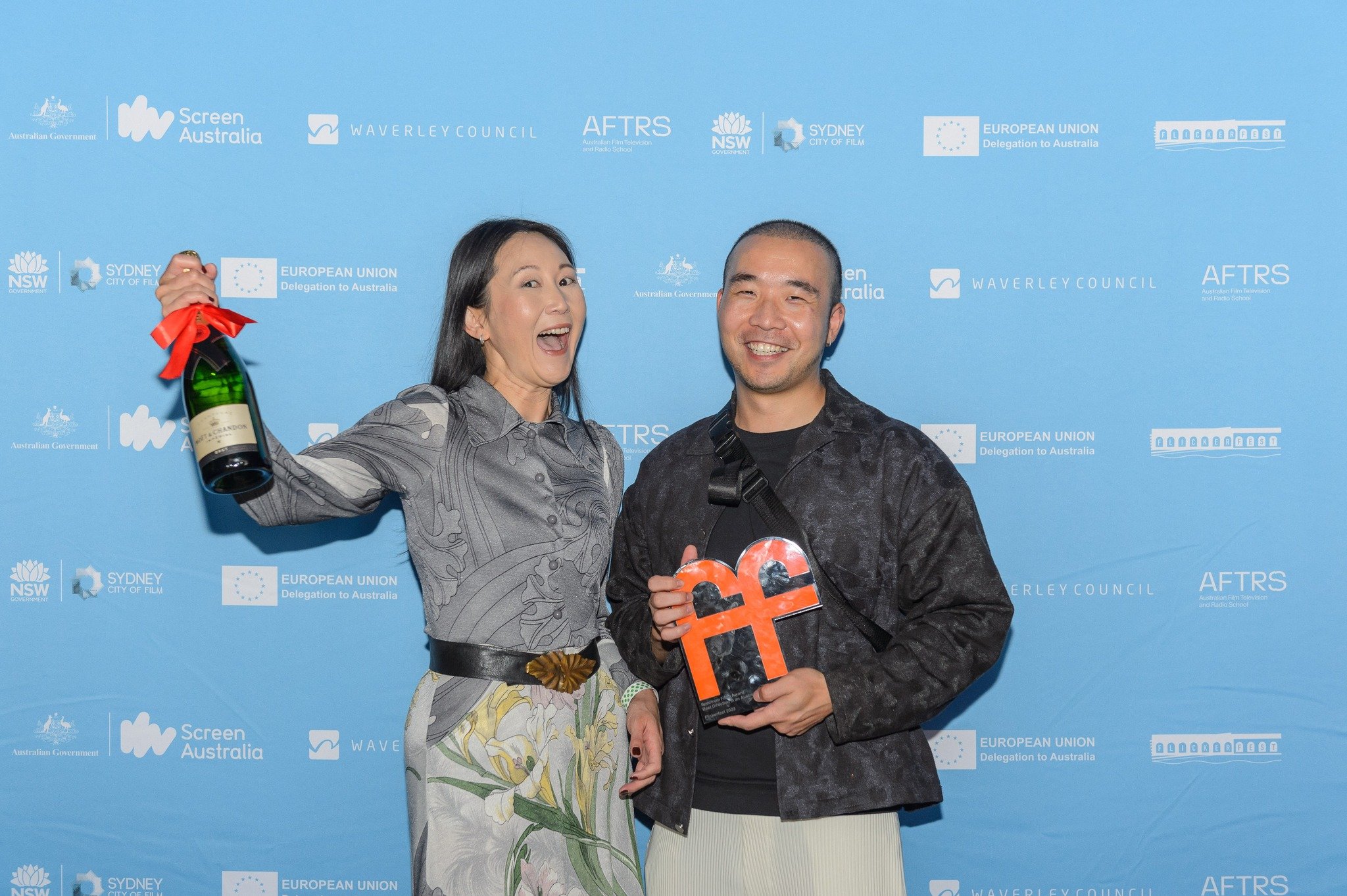

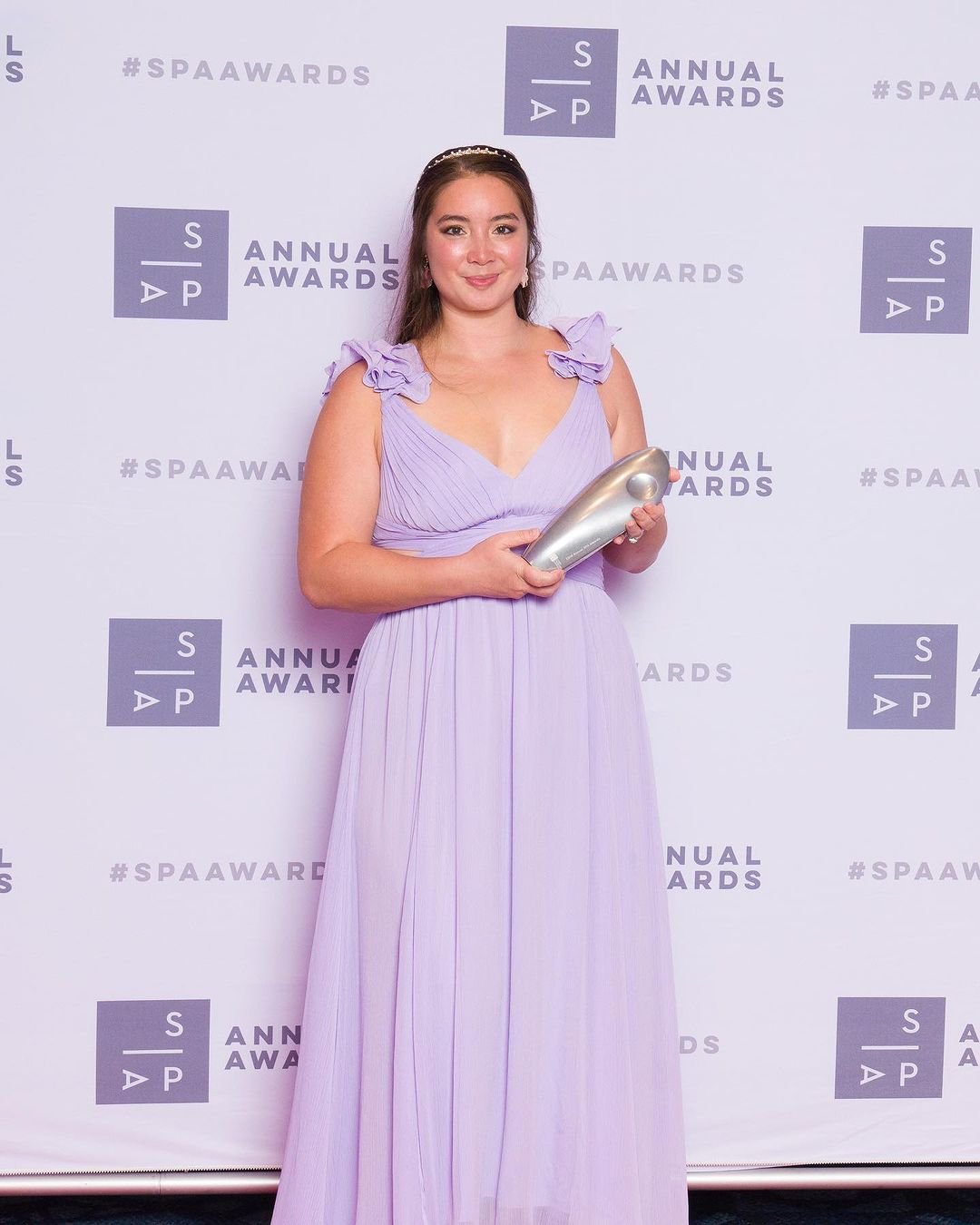
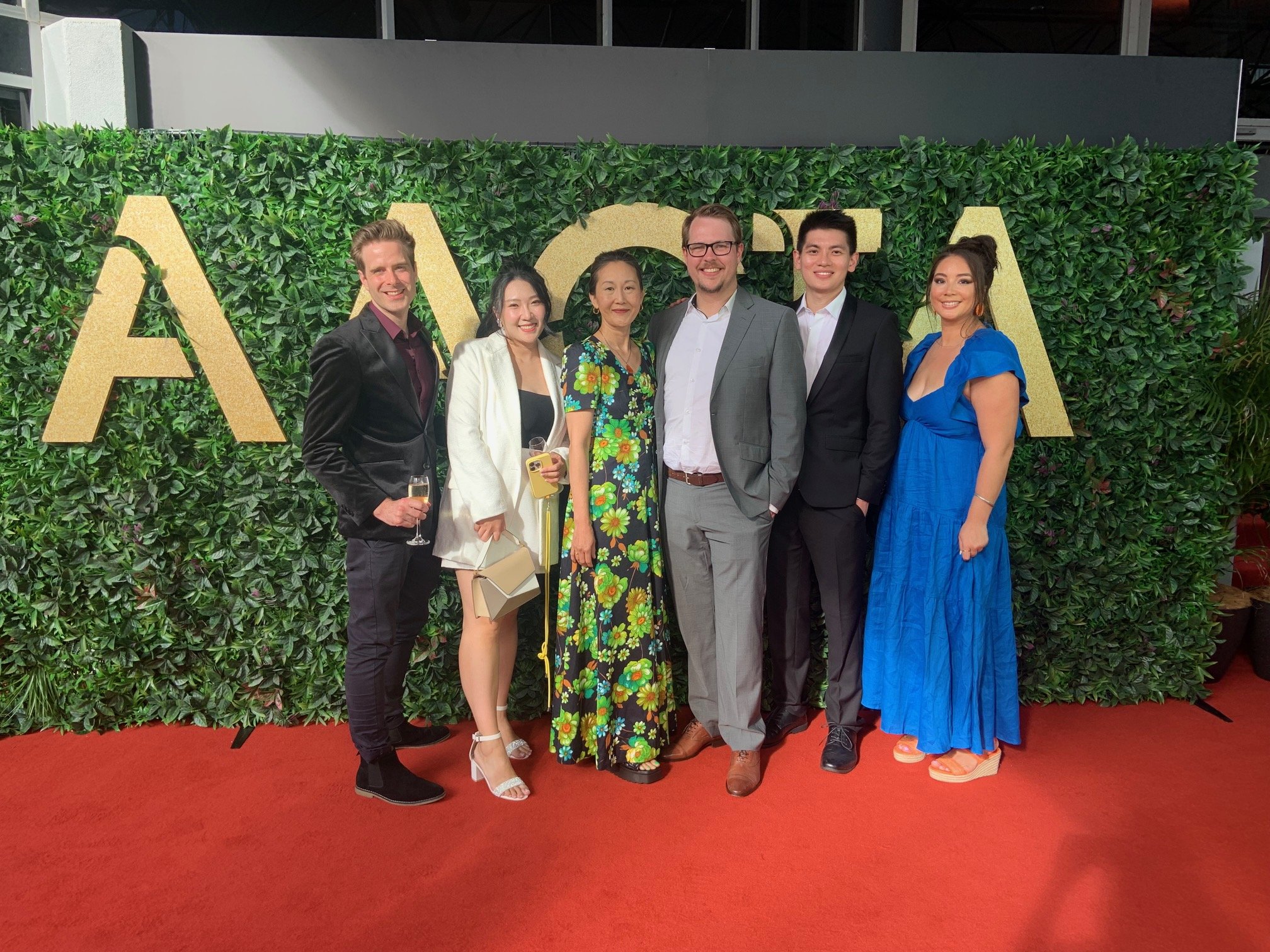
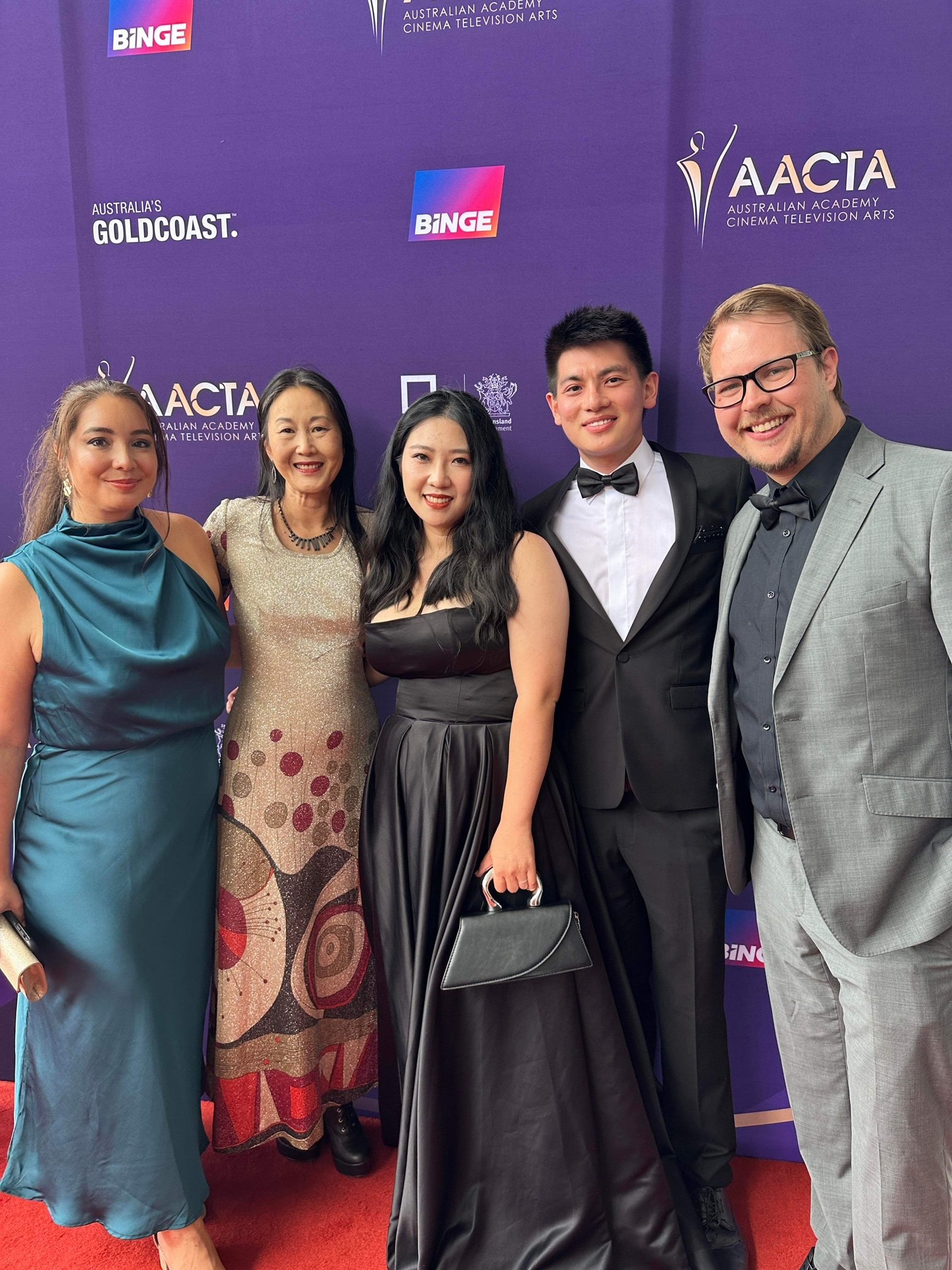
AACTA Campaigning
Round 1 (3 Aug - 21 Aug) - Campaign assets
Campaigning for the AACTA’s is not easy. There would be 2 rounds of voting before the winner was announced at the live AACTA awards broadcasted on TV. The first round of “Contenders” had over 110 submissions. These are all the films that had paid to be in the running and no one was excluded. If you paid the submission fee, you would be a contender. Each member would have 5 votes to narrow down the pool to be in the Top 5 that would go to the next round and the live ceremony. We had to find a way to stand out. During this period we also had our Victorian Premiere at MIFF. We used this period to invite everyone that we knew to come watch the film on the big screen. We gave out free tickets, sent emails and had FB Ads playing to try and put our film in front of everyone’s mind. We also had business cards made that we could give out with MIFF screening dates and a QR code with more information about the film. But our physical reach of these would only be within Victoria. In order to reach those inter-state, we had to send personal emails to AACTA members that we knew reminding them that we were in the running and to please consider us for their vote.
When promoting the film online on Facebook and Instagram, we chose 1 main still from the film that had our leads’ faces. By doing this we hoped that people would recognise the still in multiple places and immediately think of our film. We didn’t want different stills out there as some may not be recognisable as our film. Our business cards were made through Vistaprint and centred around our MIFF screenings. The QR code sent visitors to our Link Tree page which had further links to all our interviews, trailers and voting information. Out of 250 cards, we managed to give out around 100.
Round 2 (9 Dec - 8 Jan)
On 27 September we found out that we had been one of the 5 short films nominated for an AACTA. We would be going to the live ceremony and be in the running for the prestigious award. Our campaign this round was different. We ran the same Facebook ad with our trailer and laurels over the duration of the voting period and we also planned to send out personal emails to everyone once again to remind them of our nomination in the last week. However, Vee and I were also in China during this period shooting our next project - Our debut feature film Time and Tide, when we found out that the closing date of this round was brought forward by a week. We had scheduled emails and reminders for the last few days but it was too late. We only had to hope that we got enough votes.
Unfortunately we did not win the award and our AACTA run came to an end.
Festivals and Awards
Our 2-year festival run began on January 2023 and ended around January 2024. In total we entered into over 125 festivals and guild awards, got accepted into 30 and won over 10 awards. I would consider anything over a 10% acceptance rate a success. All our awards and nominations are listed below in order of date.
Flickerfest 2023
USAFF 2023
20th In The Palace International short film festival 2023
Regina International Film Festival & Awards 2023
Melbourne International Film Festival 2023
Vancouver Queer Film Festival 2023
Cinefest OZ Film Festival 2023
Melbourne Multicultural Film Festival 2023
Brisbane International Film Festival 2023
Tels Quels Festival Brussels 2023
Canberra Short Film Festival 2023
Melbourne Queer Film Festival 2023
Midsumma Festival 2024
Australia Independent Film Festival 2023
AACTA Awards 2024
Lublin Film Festival 2023
Australian Directors Guild 2023
Screen Producers Australia 2024
AWGIE 2024
Stellar Film Festival 2024
Auckland pride festival 2024
Pride Film Fest 2024
Heart Of Gold Film Festival 2024
Sony Catchlight Film Festival
Iris Prize 2024
Winner of Spectrum Films Award for Best Direction in an Australian Short Film &
Special Mention for Best Actor in an Australian Short Film - Sel Hiew
Honourable Mention, Narrative
Official selection
Official Selection - In Competition
Official Selection
Official Selection
Official Selection
Official Selection
Honourable Mention (Best Short Film), People's choice Award
Official Selection
Winner - Jury Award
National Award: Best Cinematography
City of Melbourne Award for Best Australian Short Film
Official Selection
Best Australian Short Film 2023
Nominee for Best Short Film
Official Selection
Winner of ADG Best Direction in a Student Film
Winner of Short Film Production of the Year
Winner of Best Short Film Script of the Year
Winner of Best Performance - Sel Hiew
Official Selection
Official Selection
Winner of Best Australian Film
Runner up in Fiction Category - Nicholson Ren
Winner of Best Short Film Youth Award
Distribution
Following our success in the film festival circuit we found a few distributors reaching out to partner with us from all over the world. Below is a list of platforms and distributors which we’ve partnered with.









